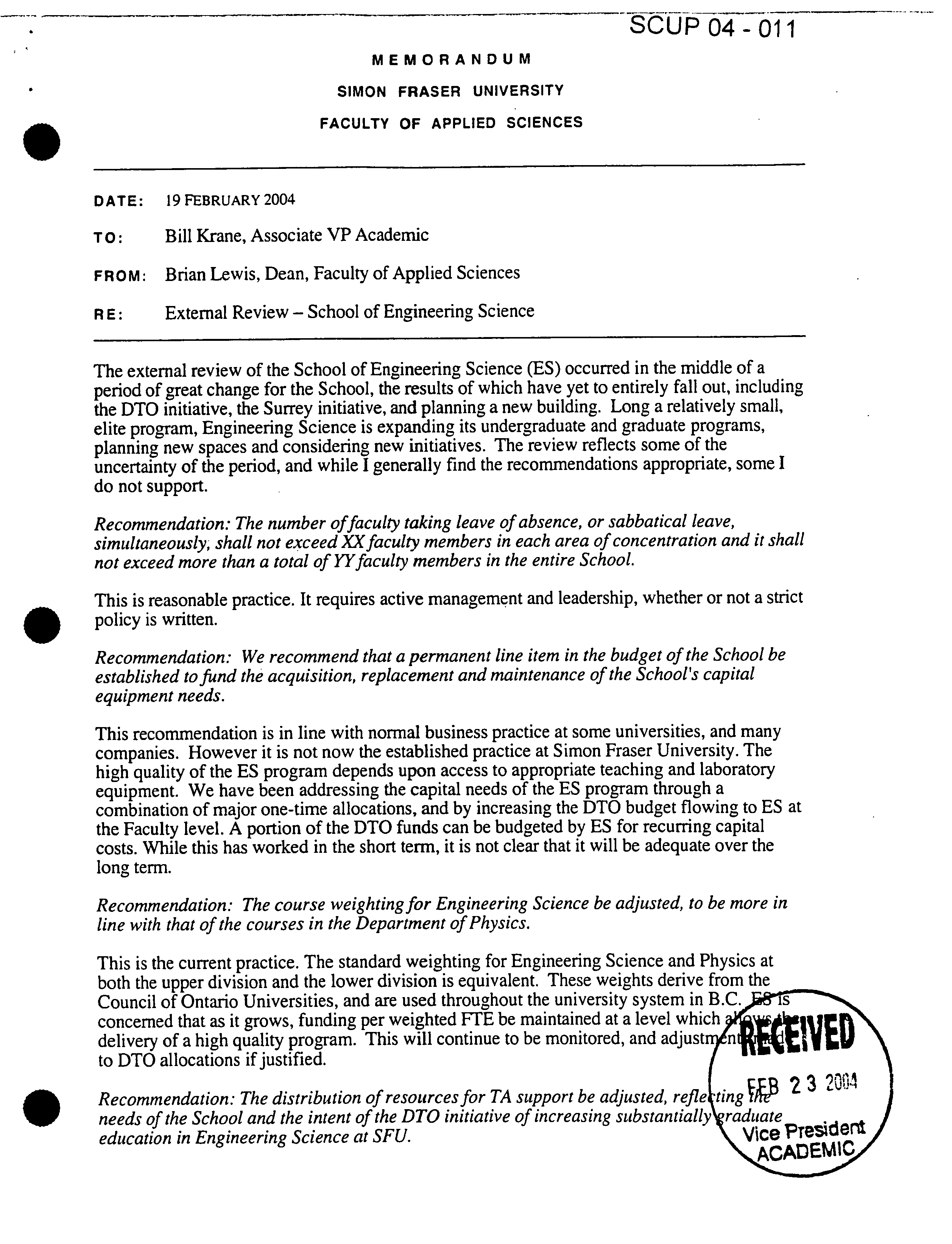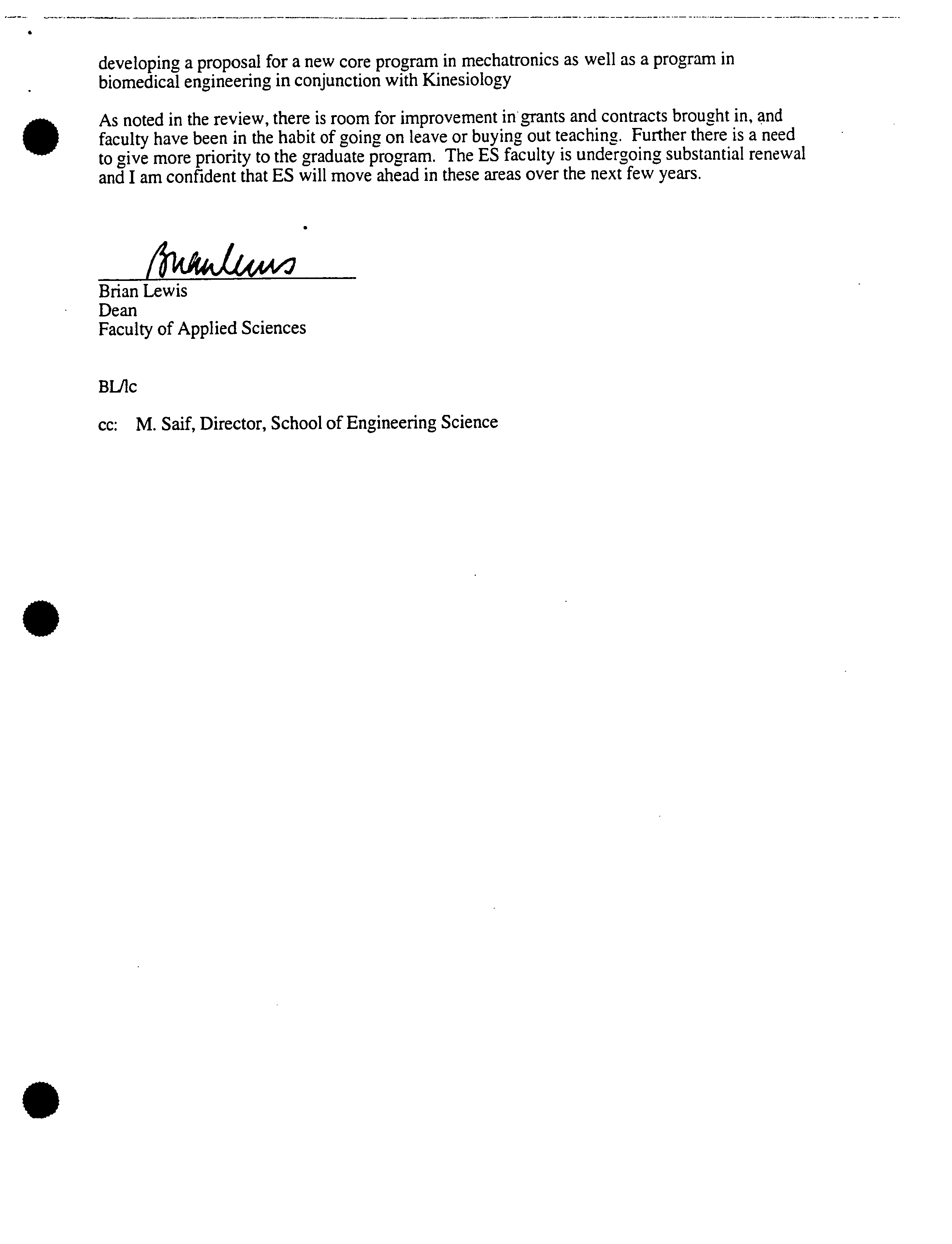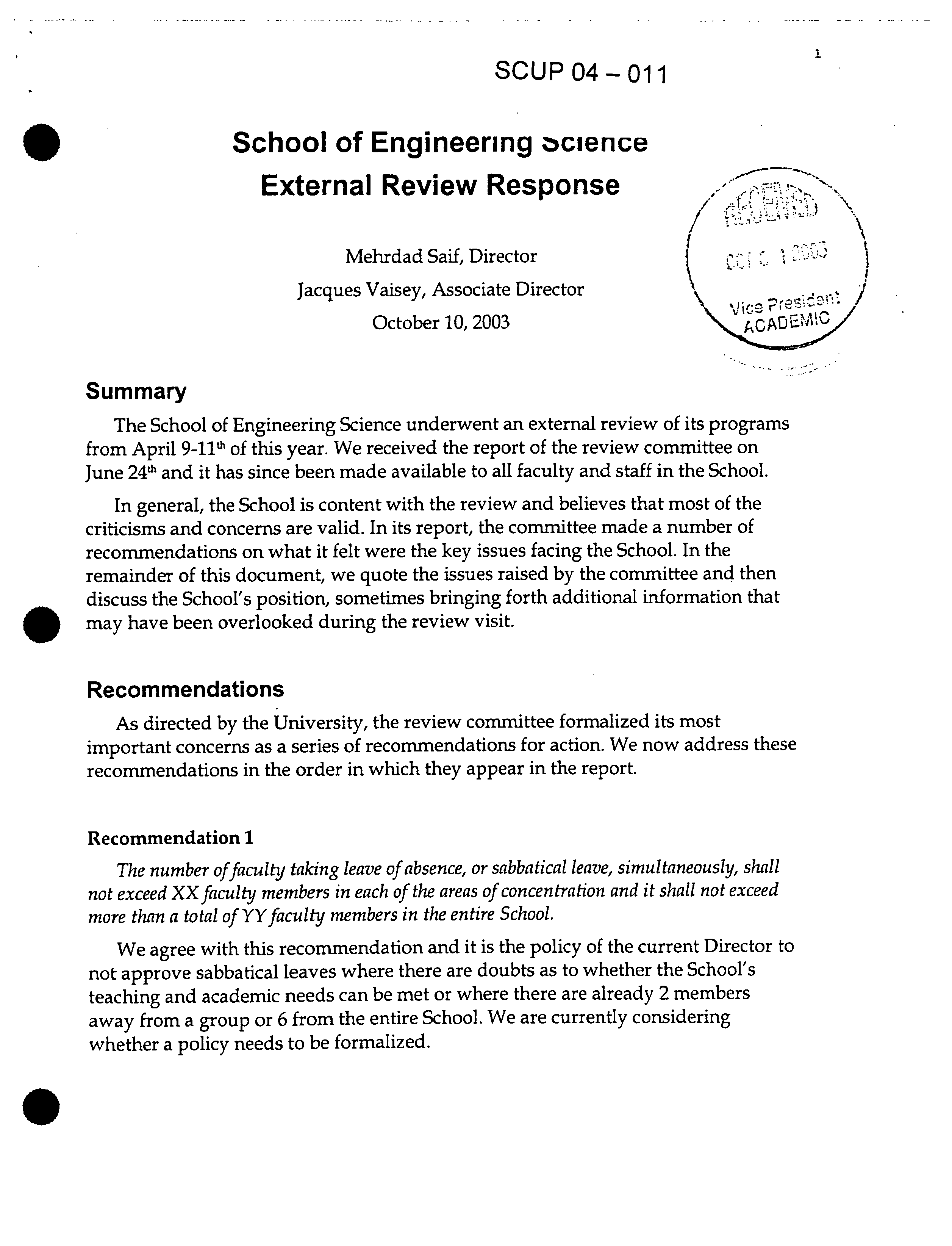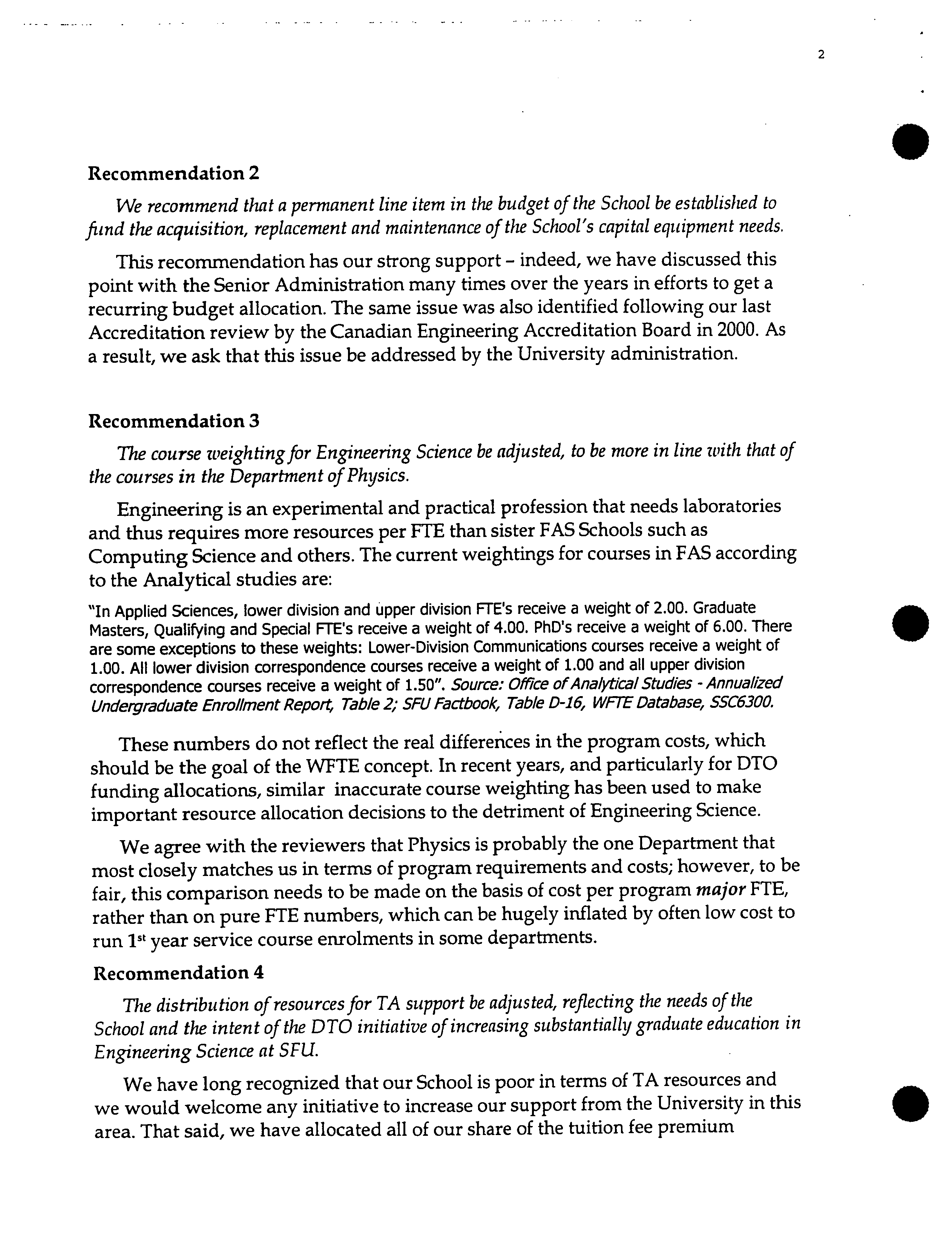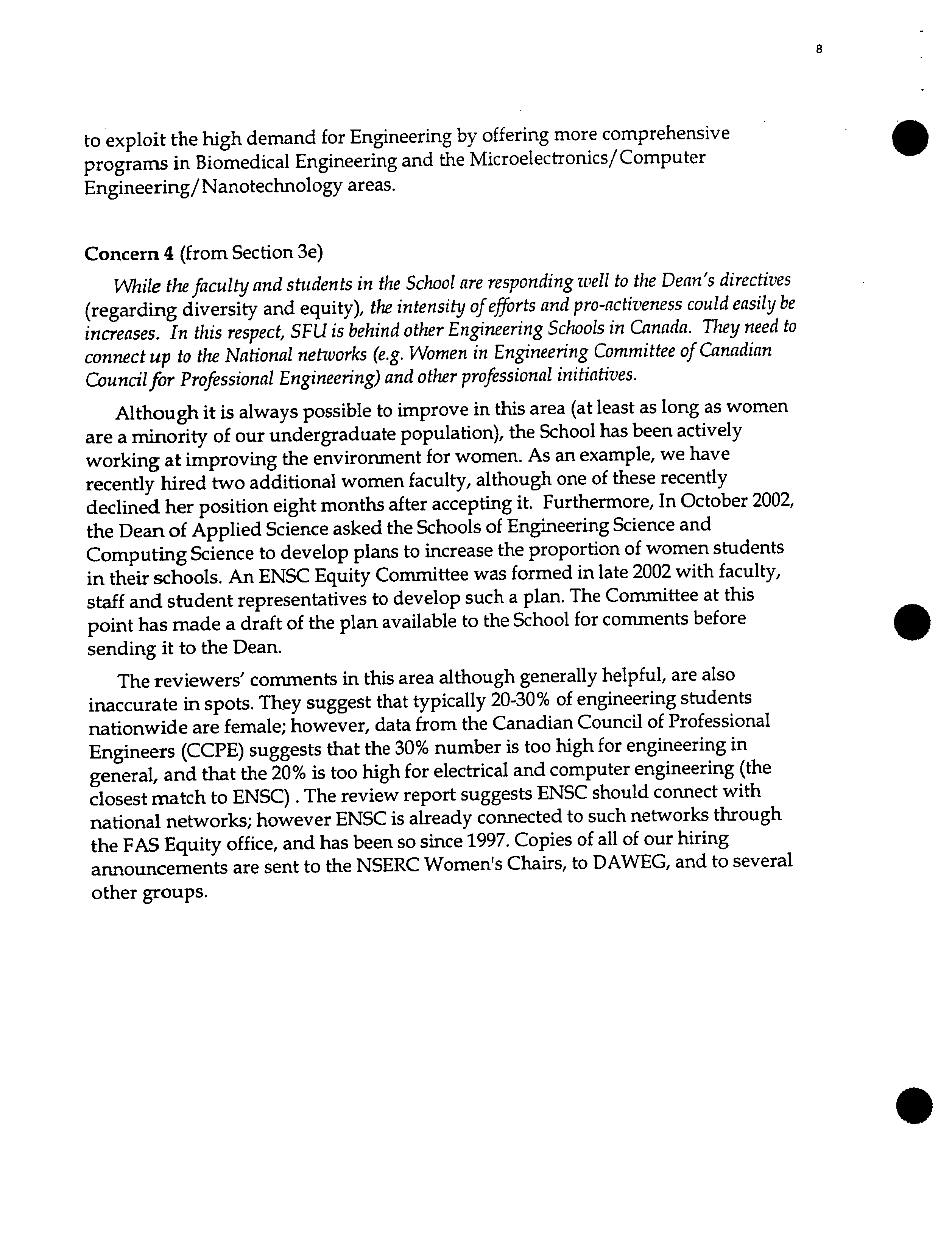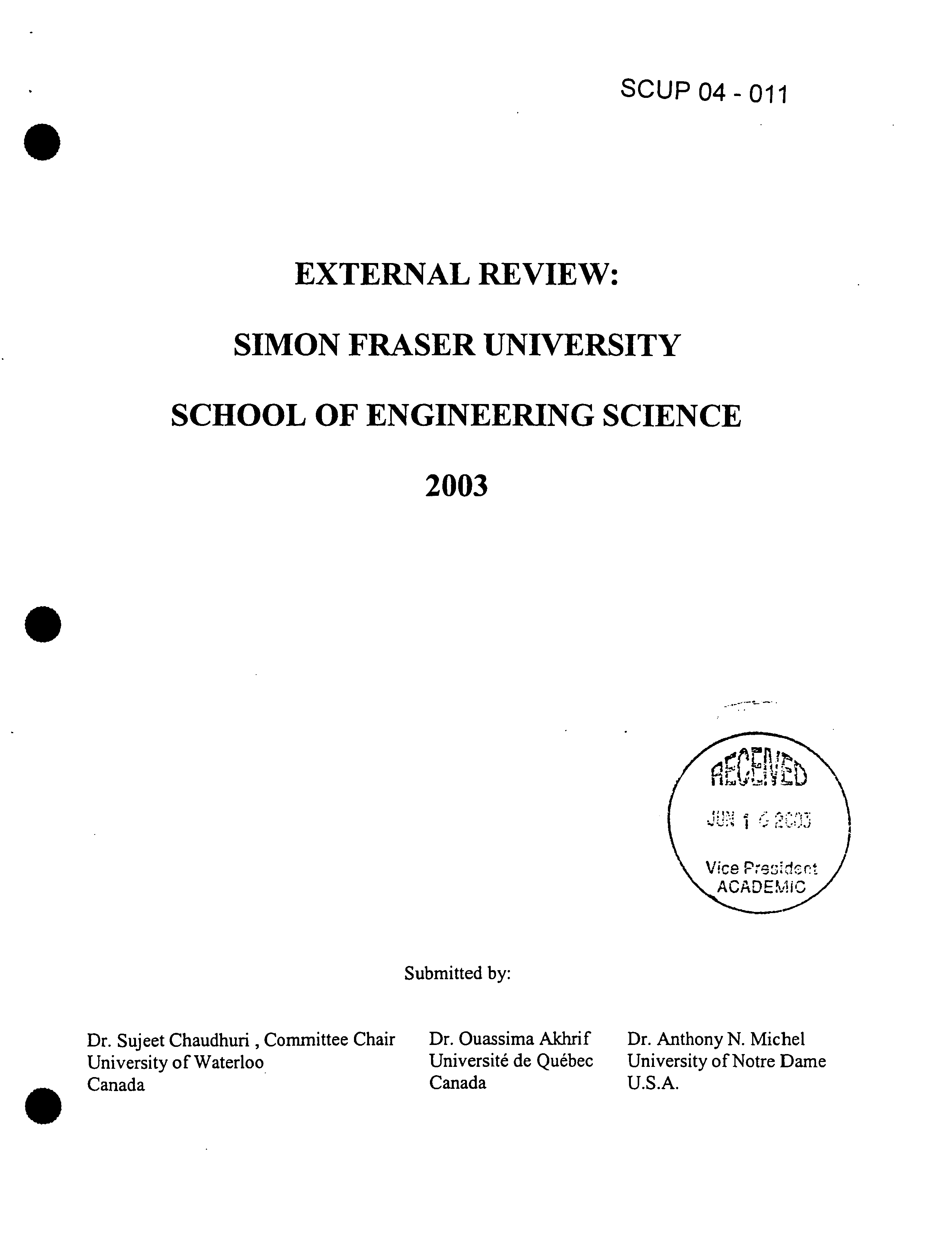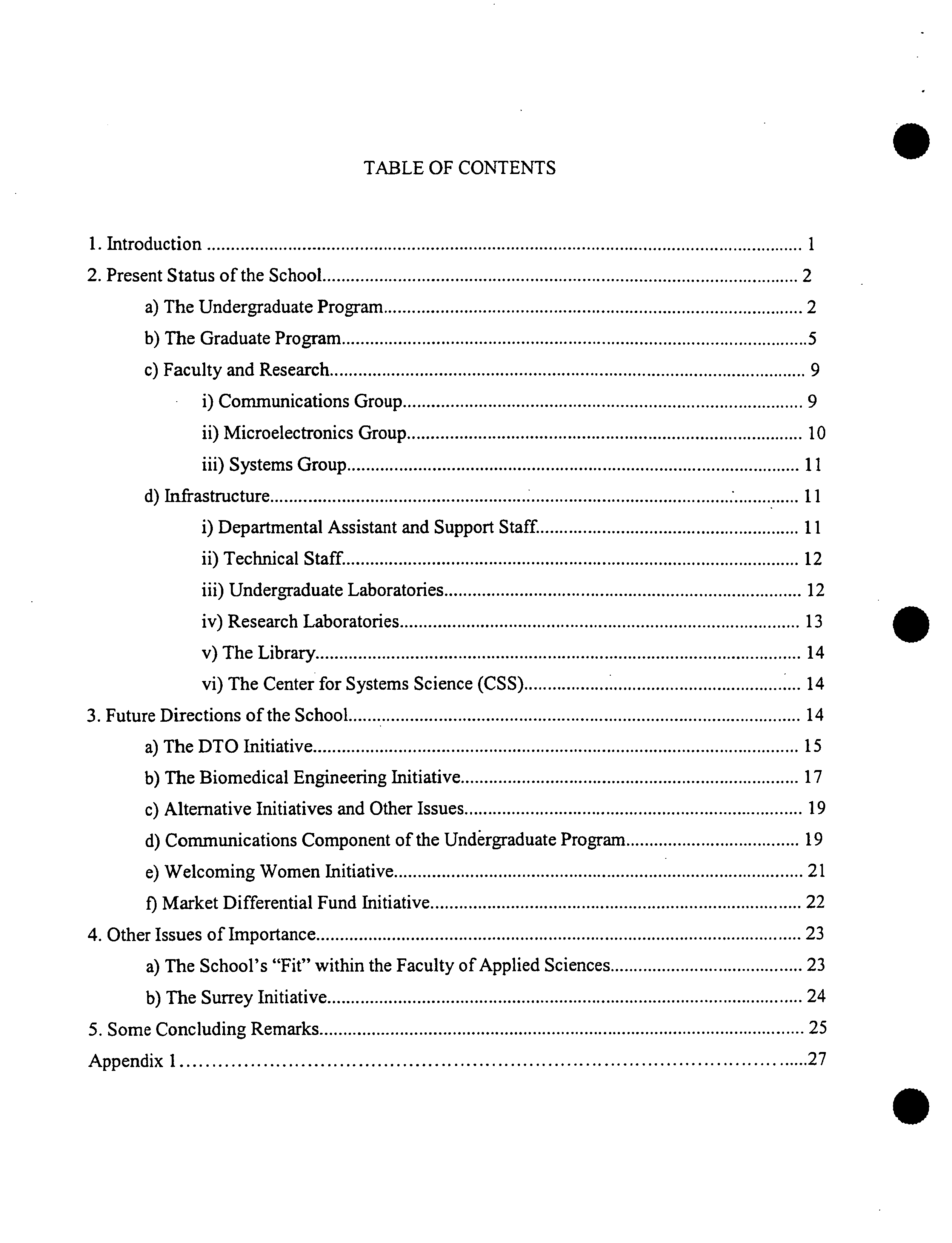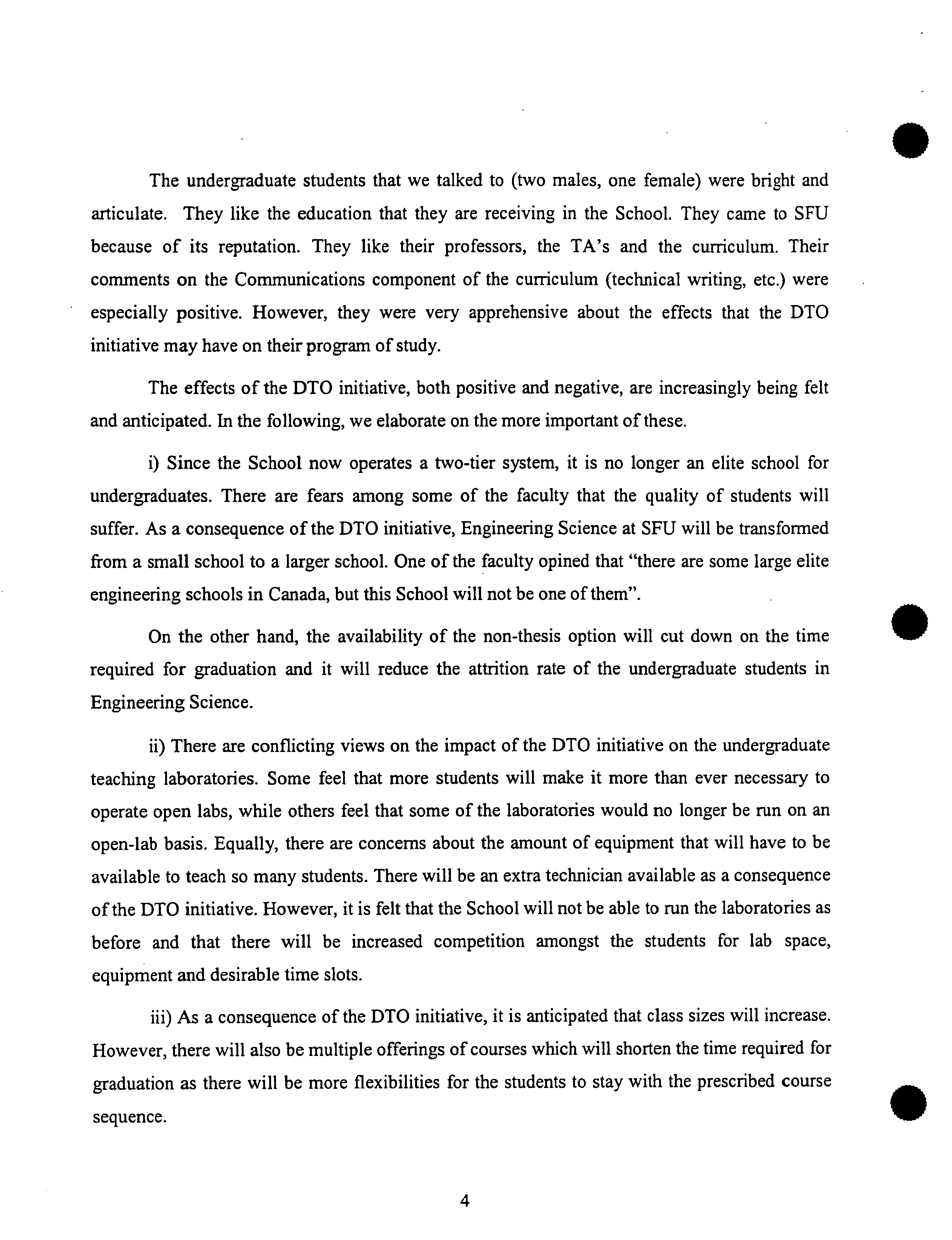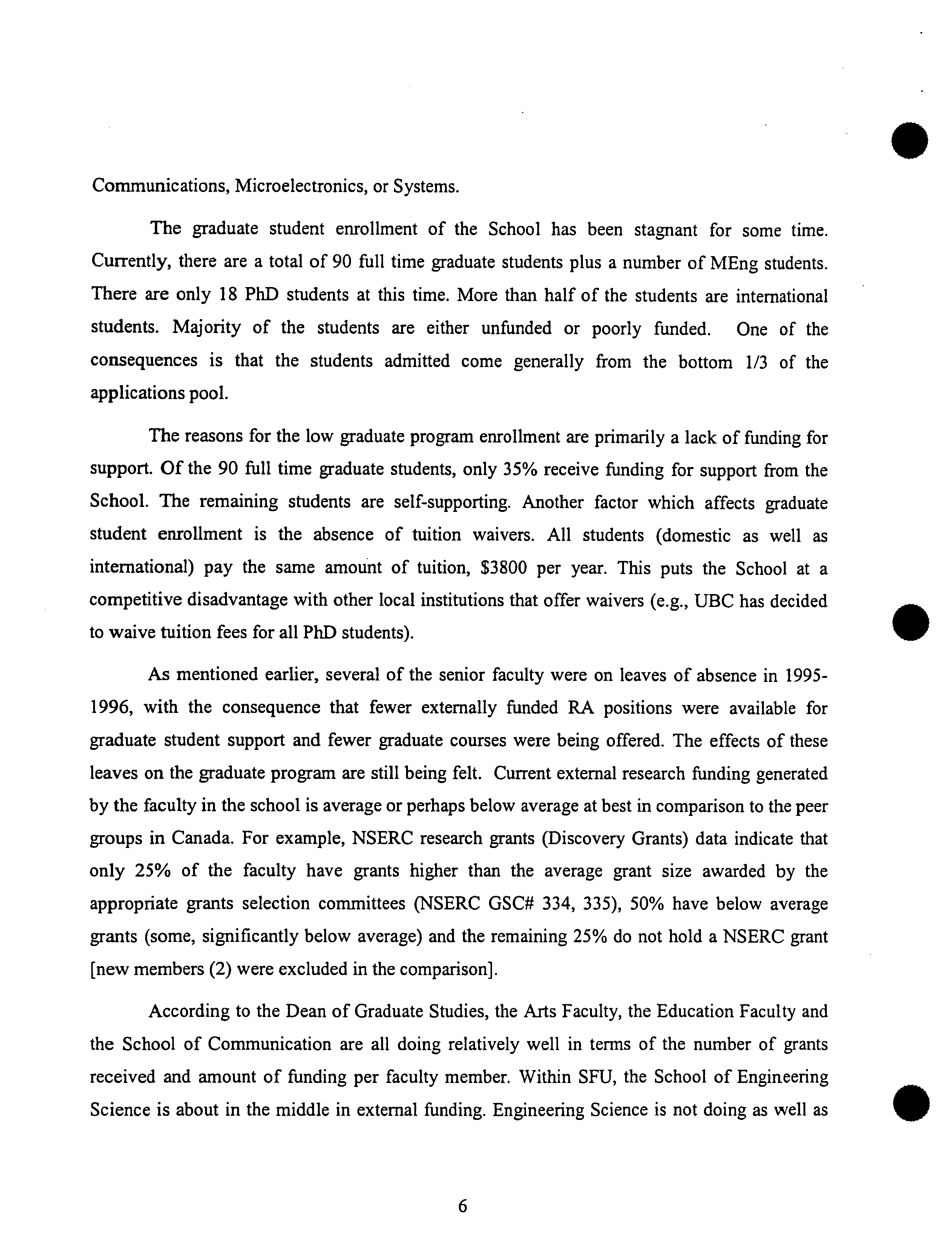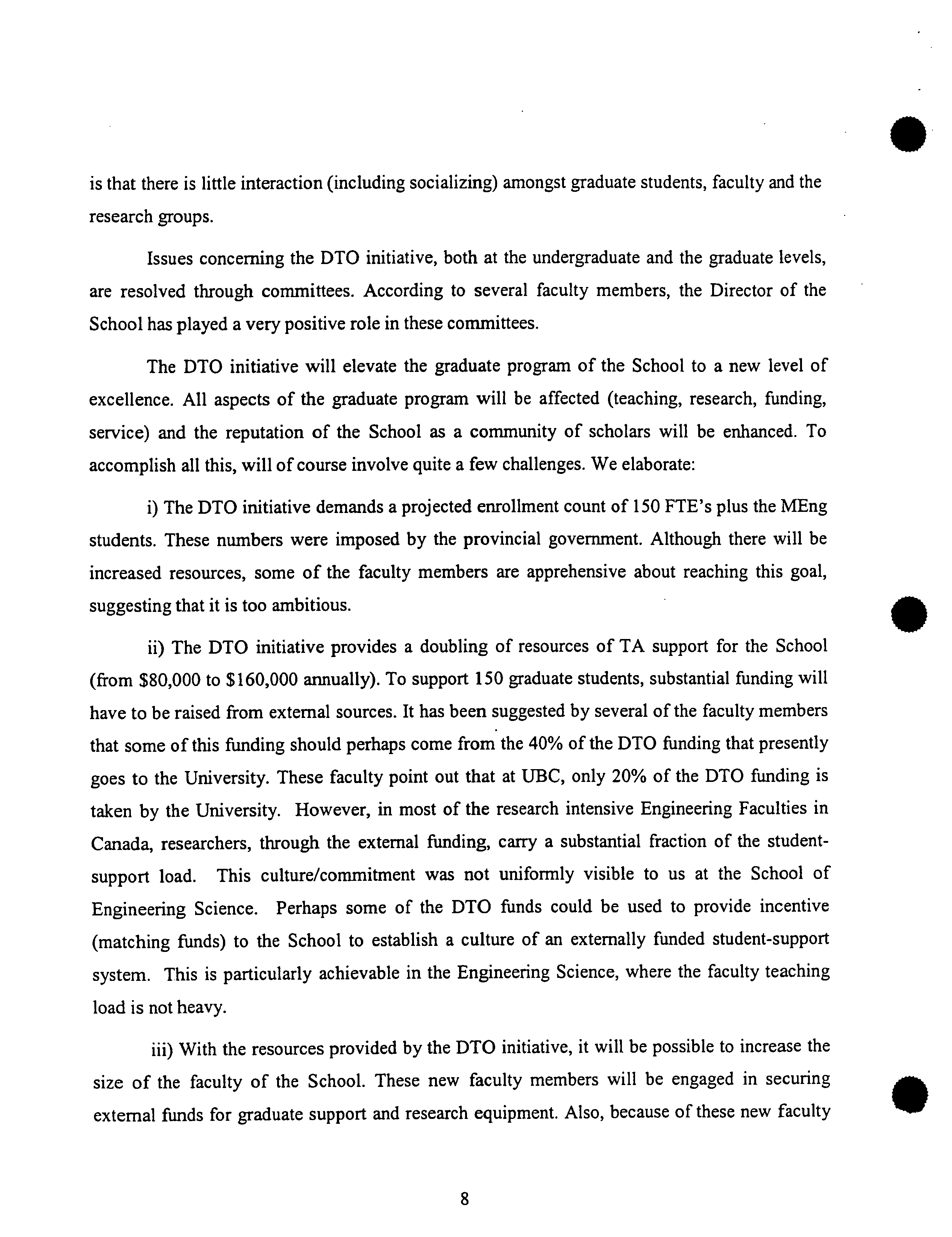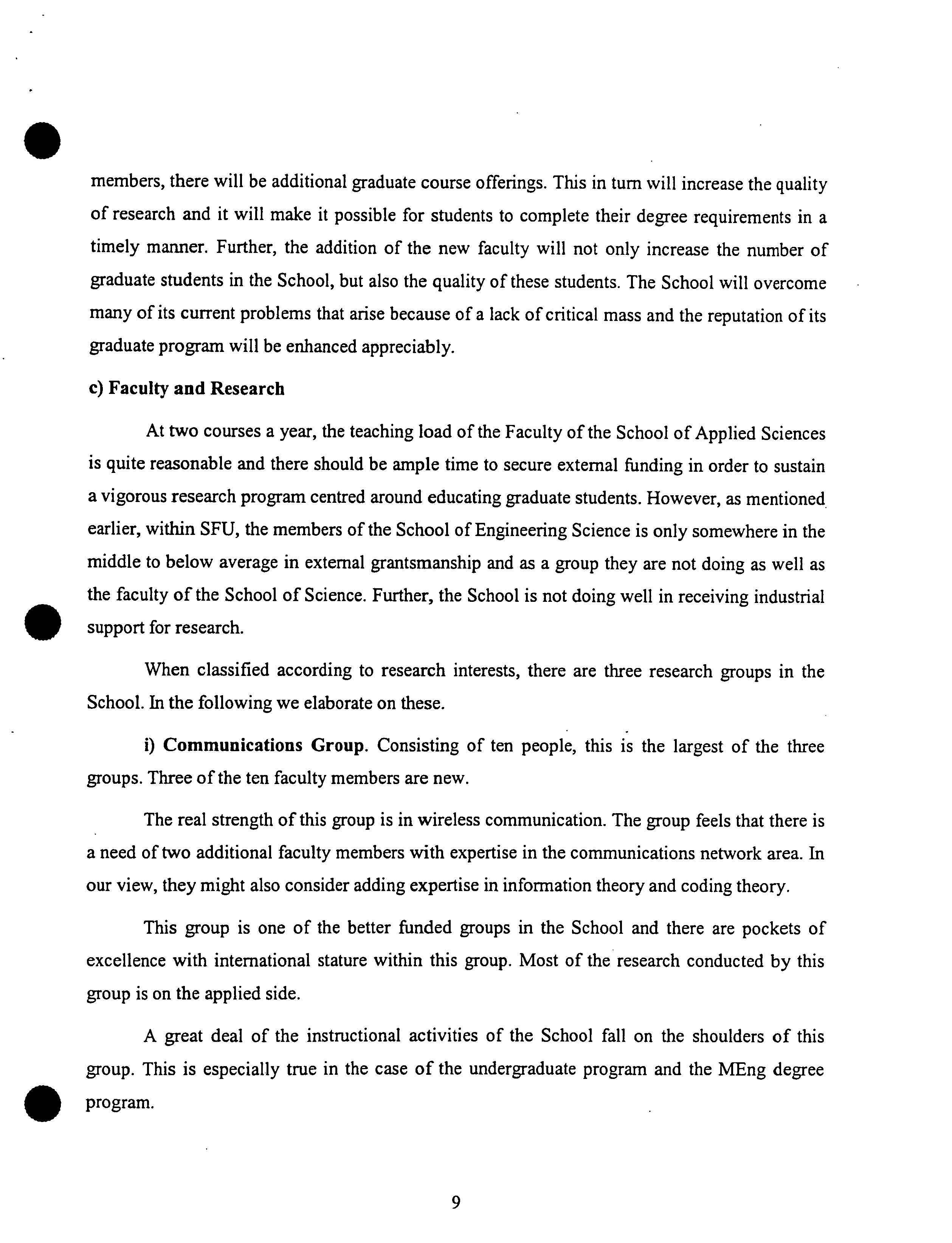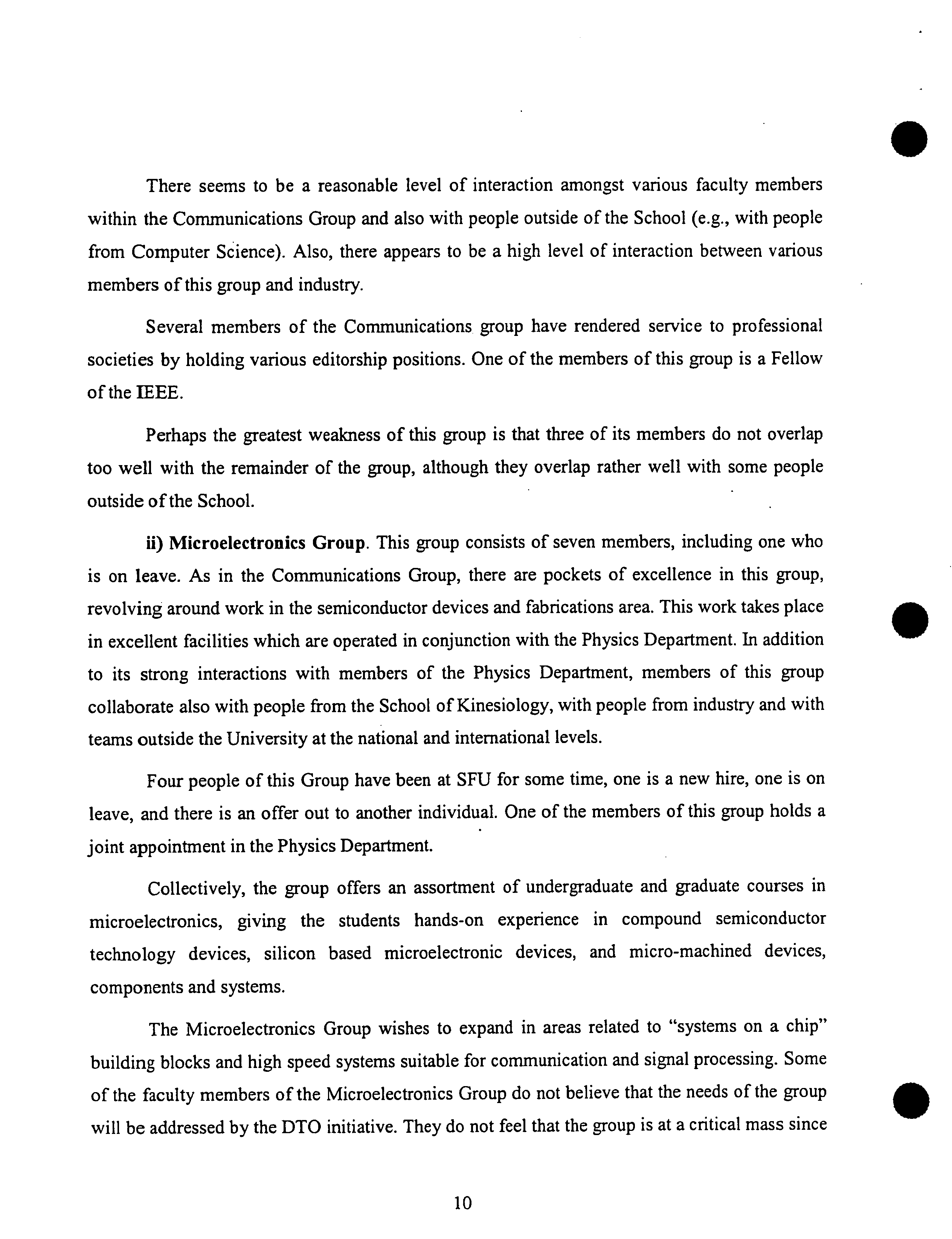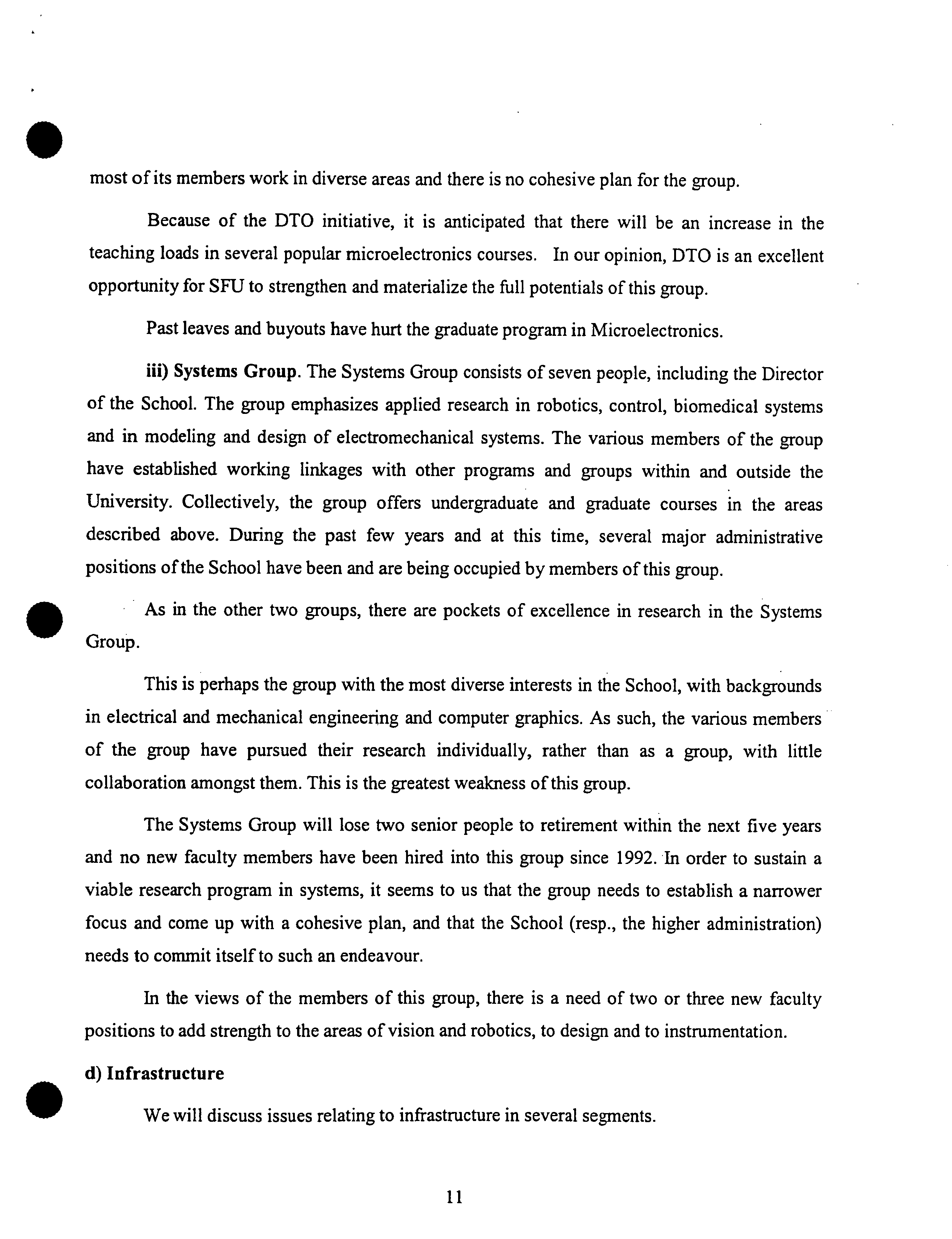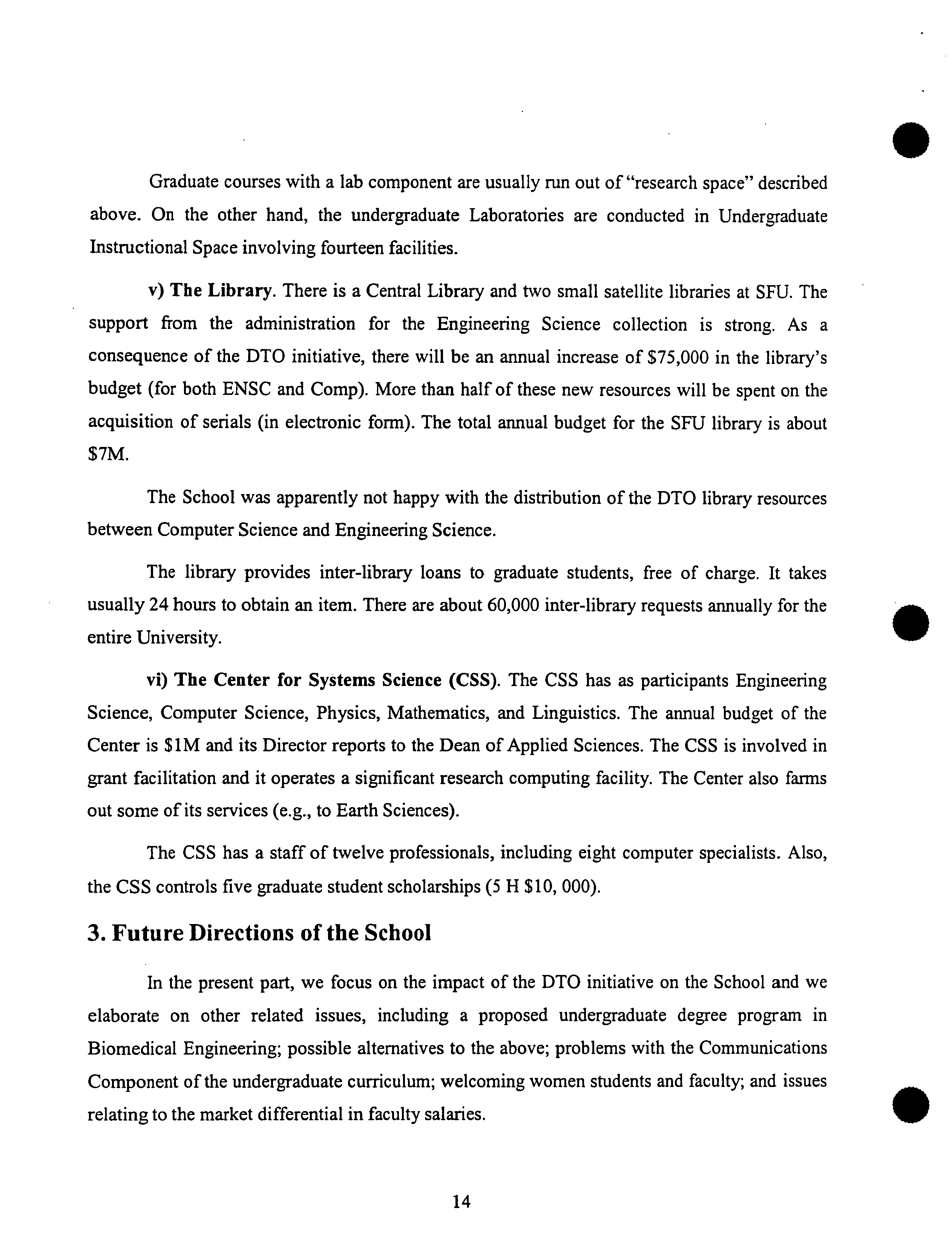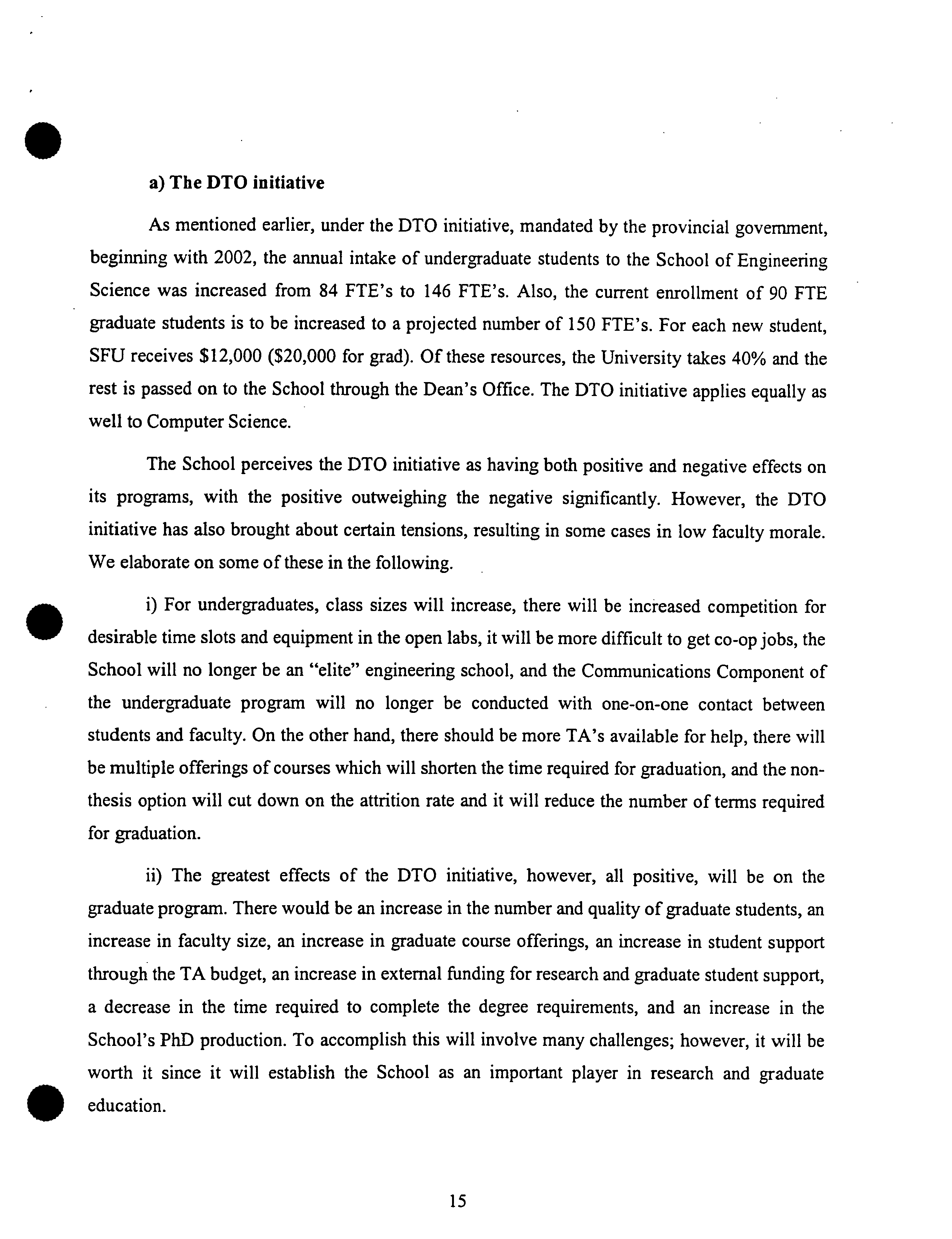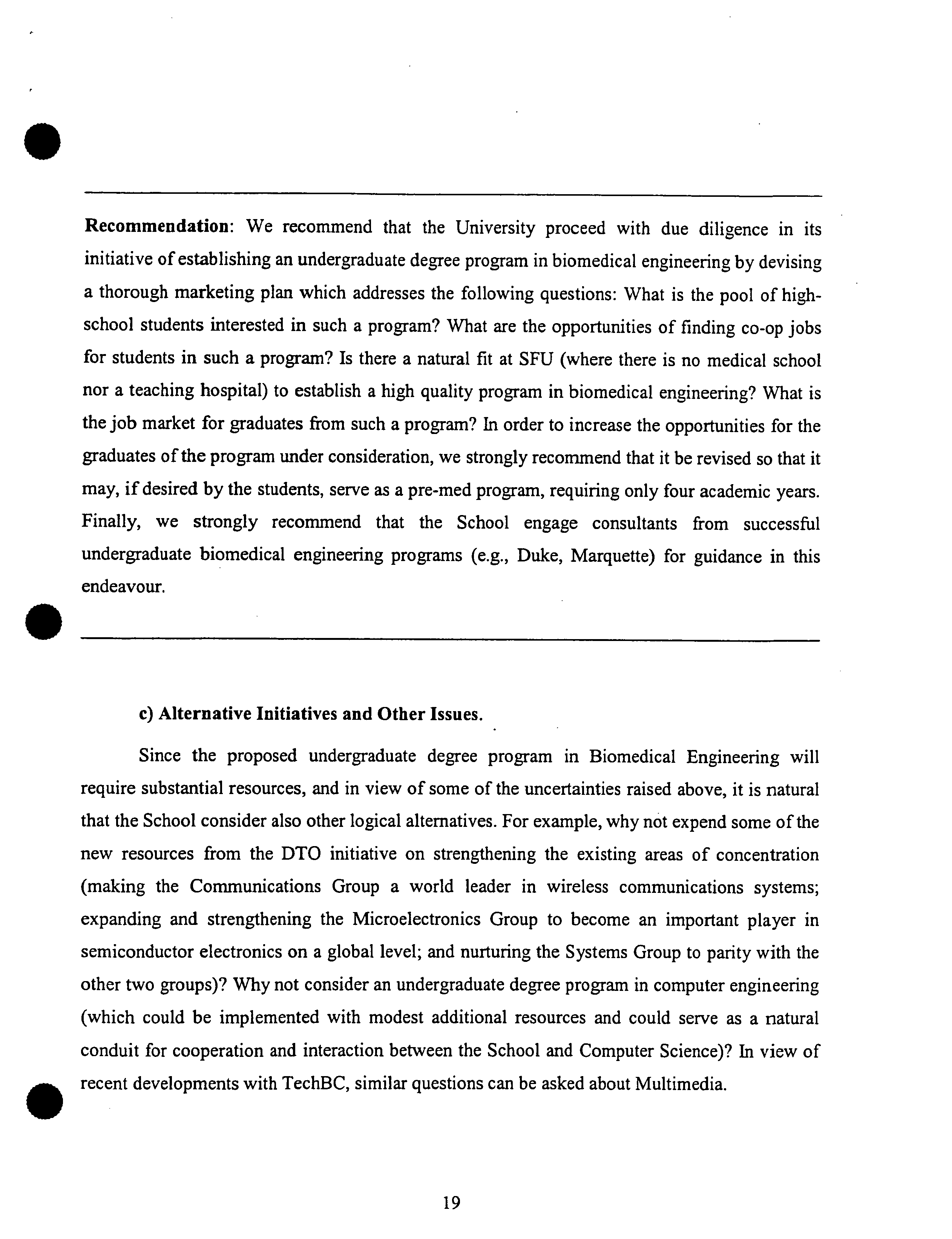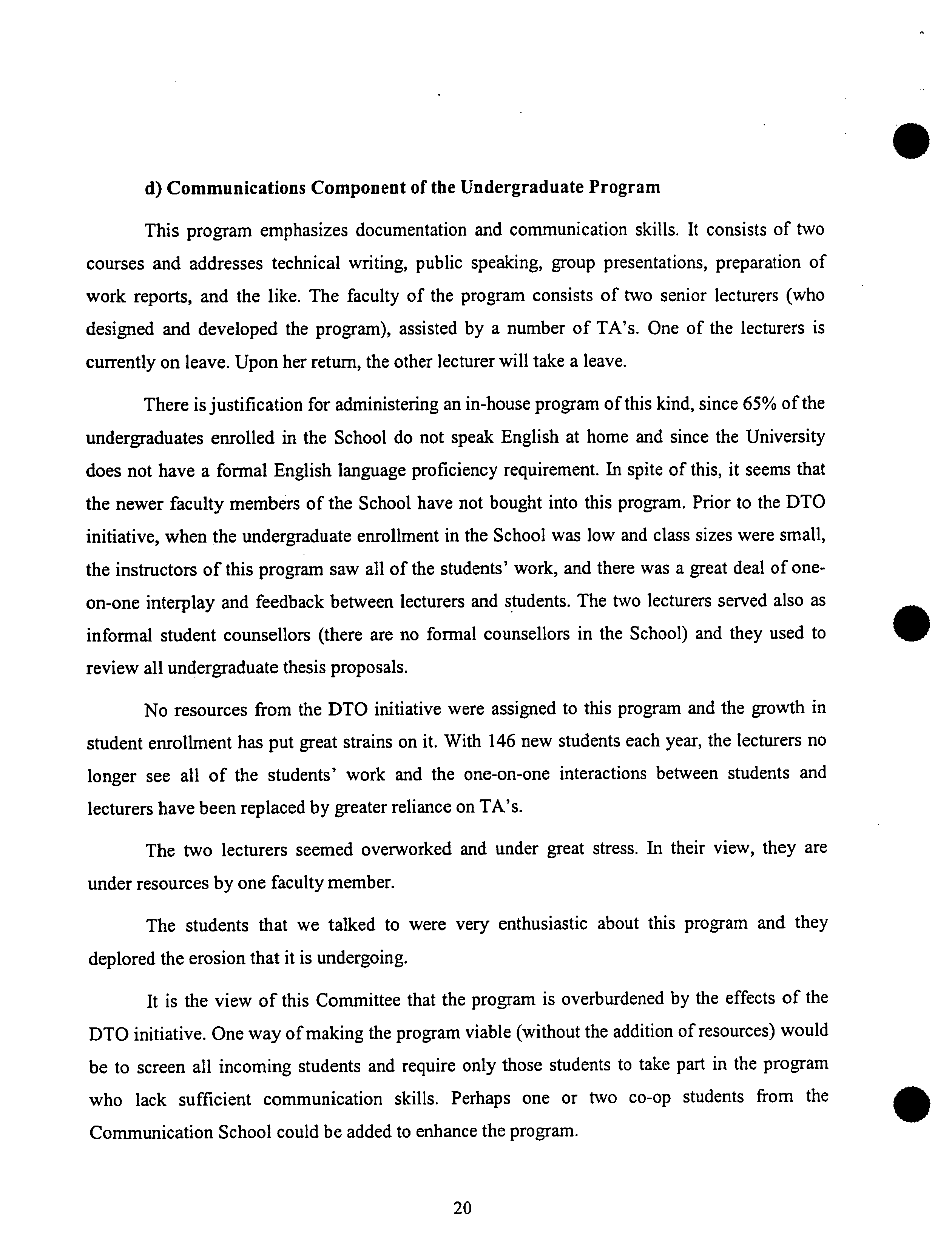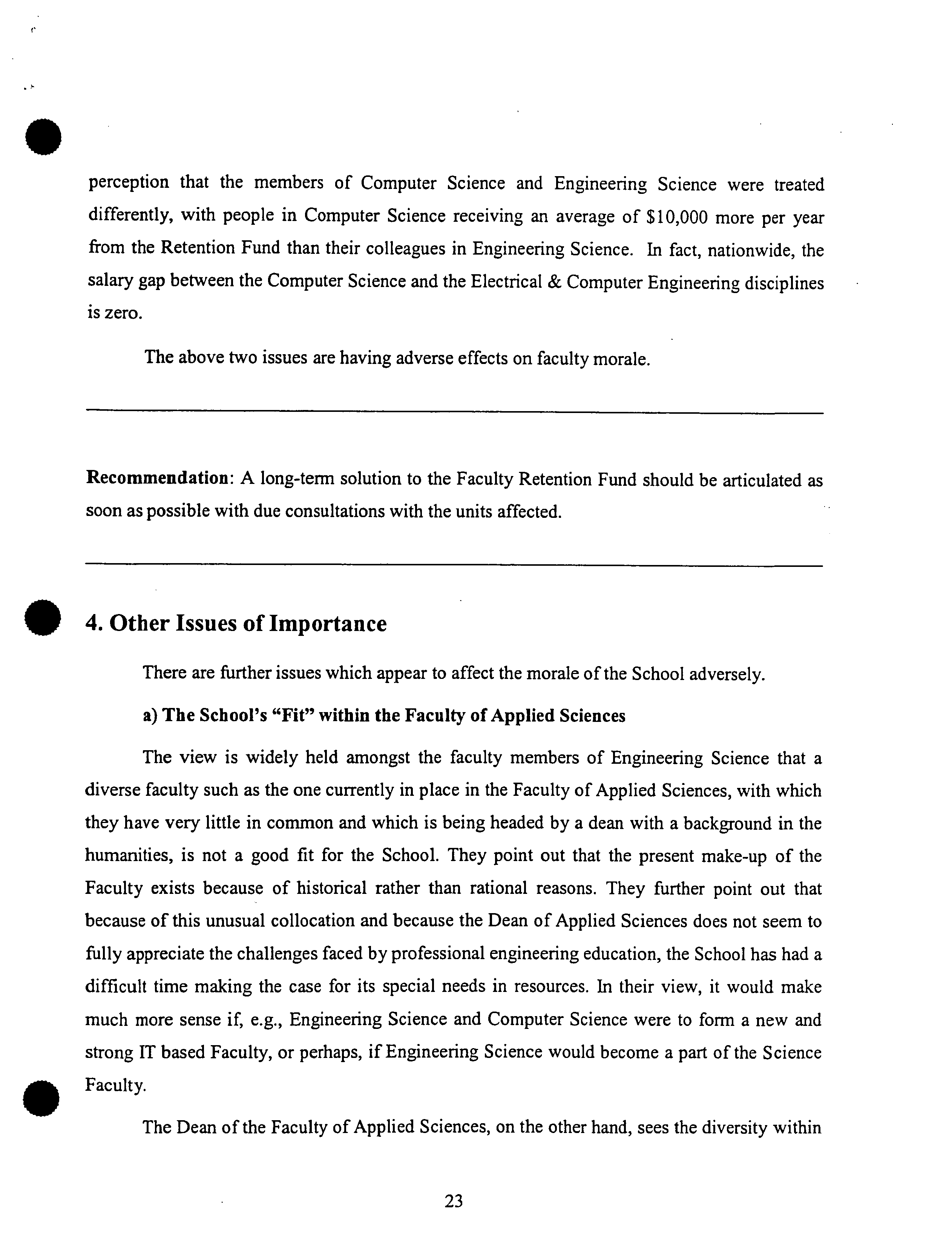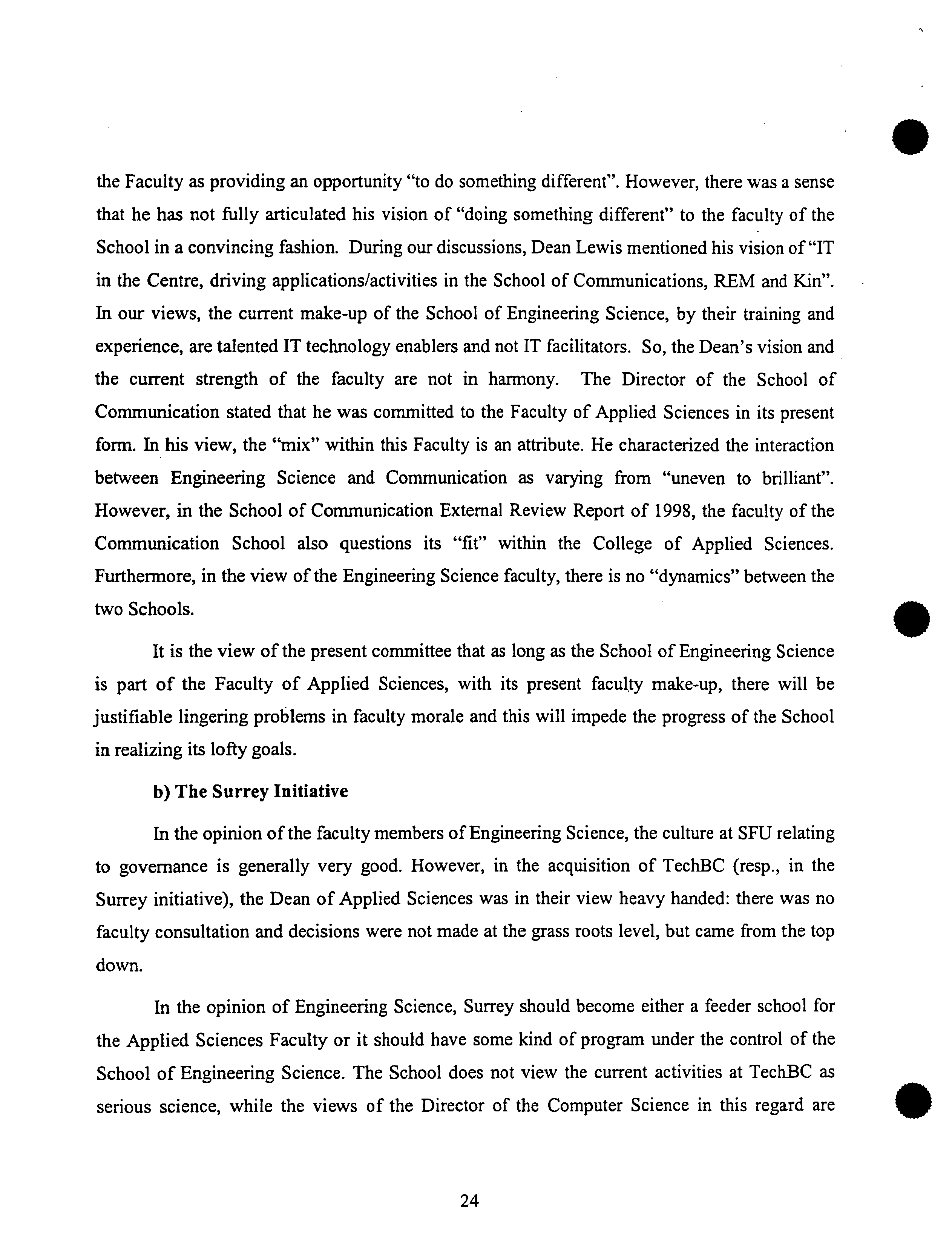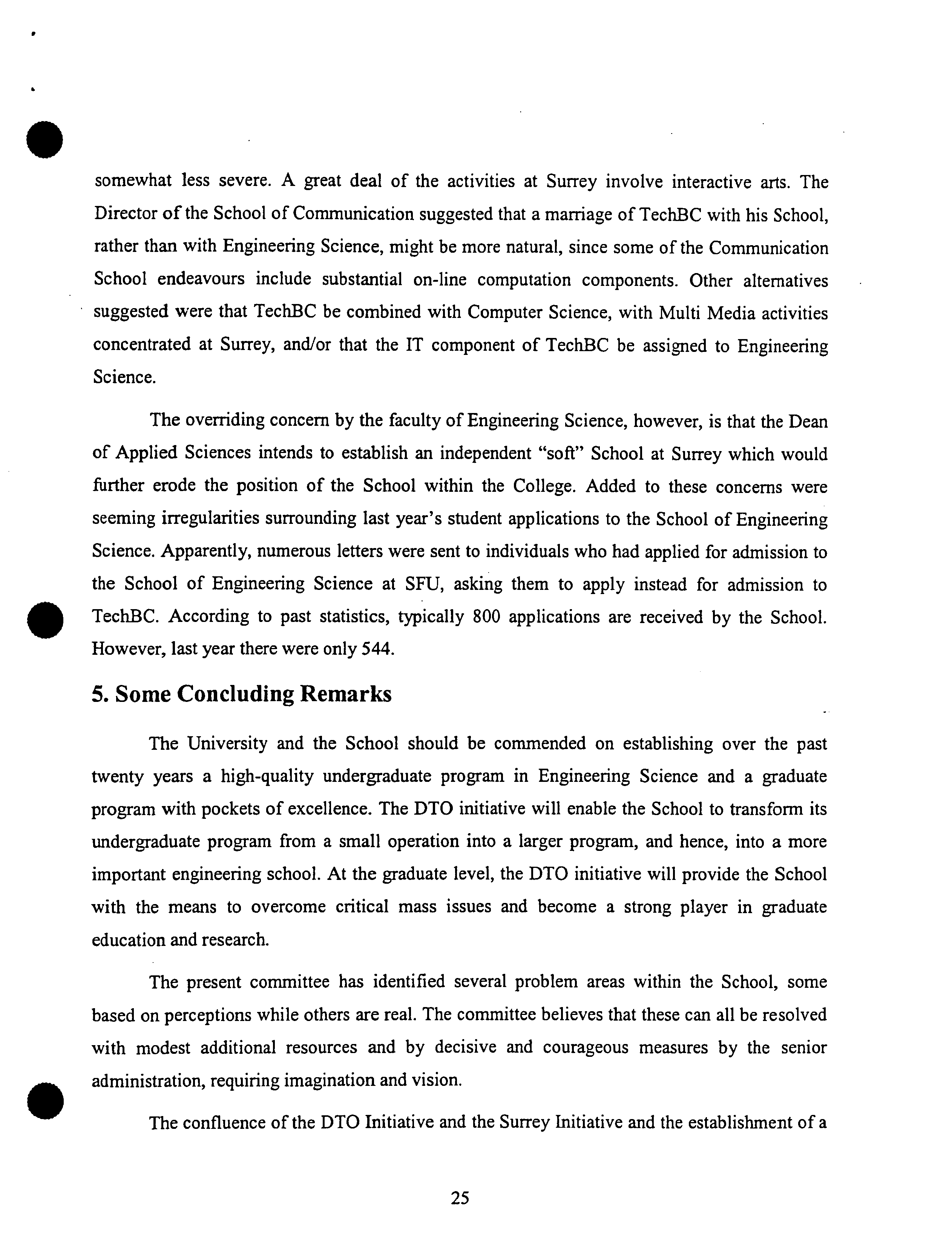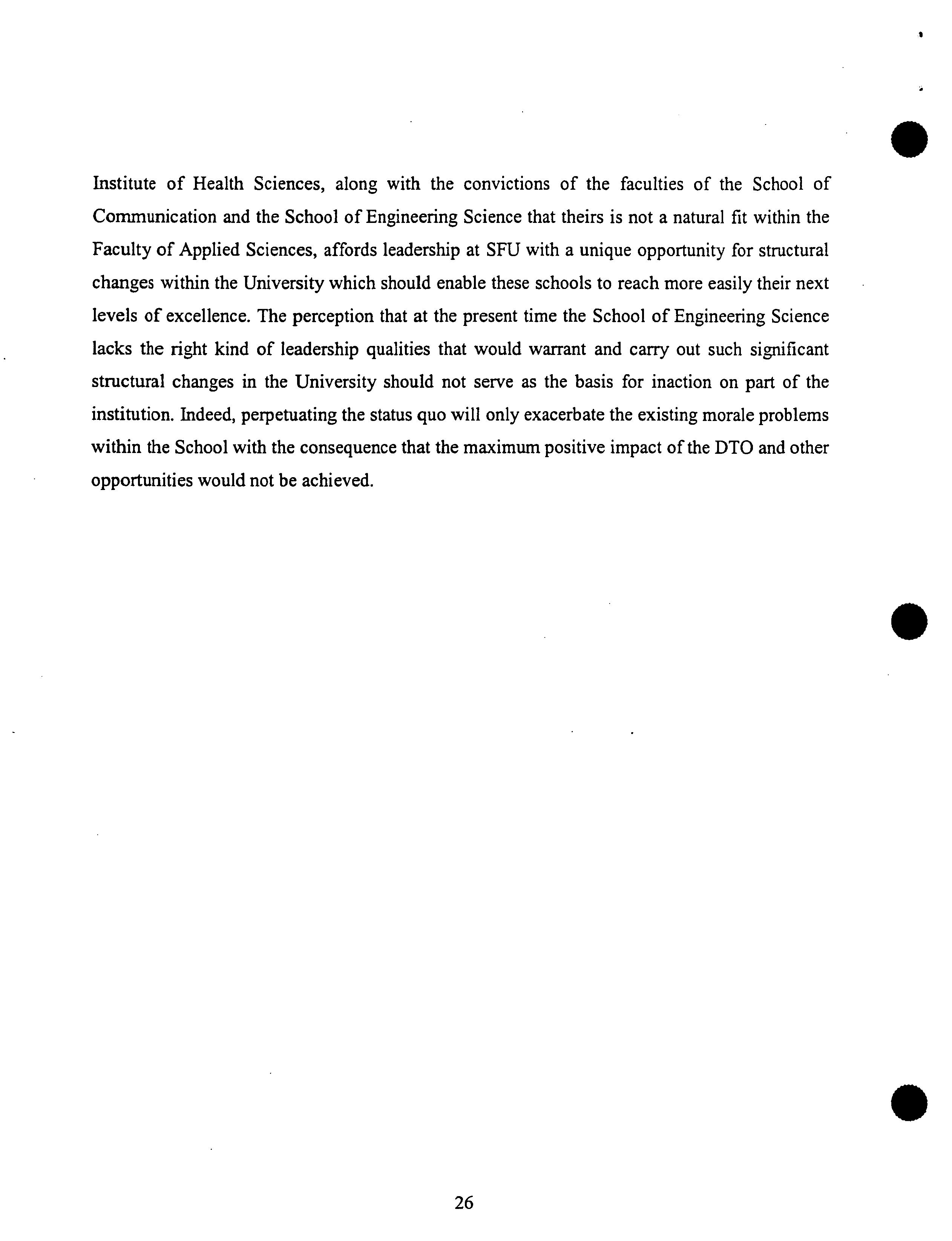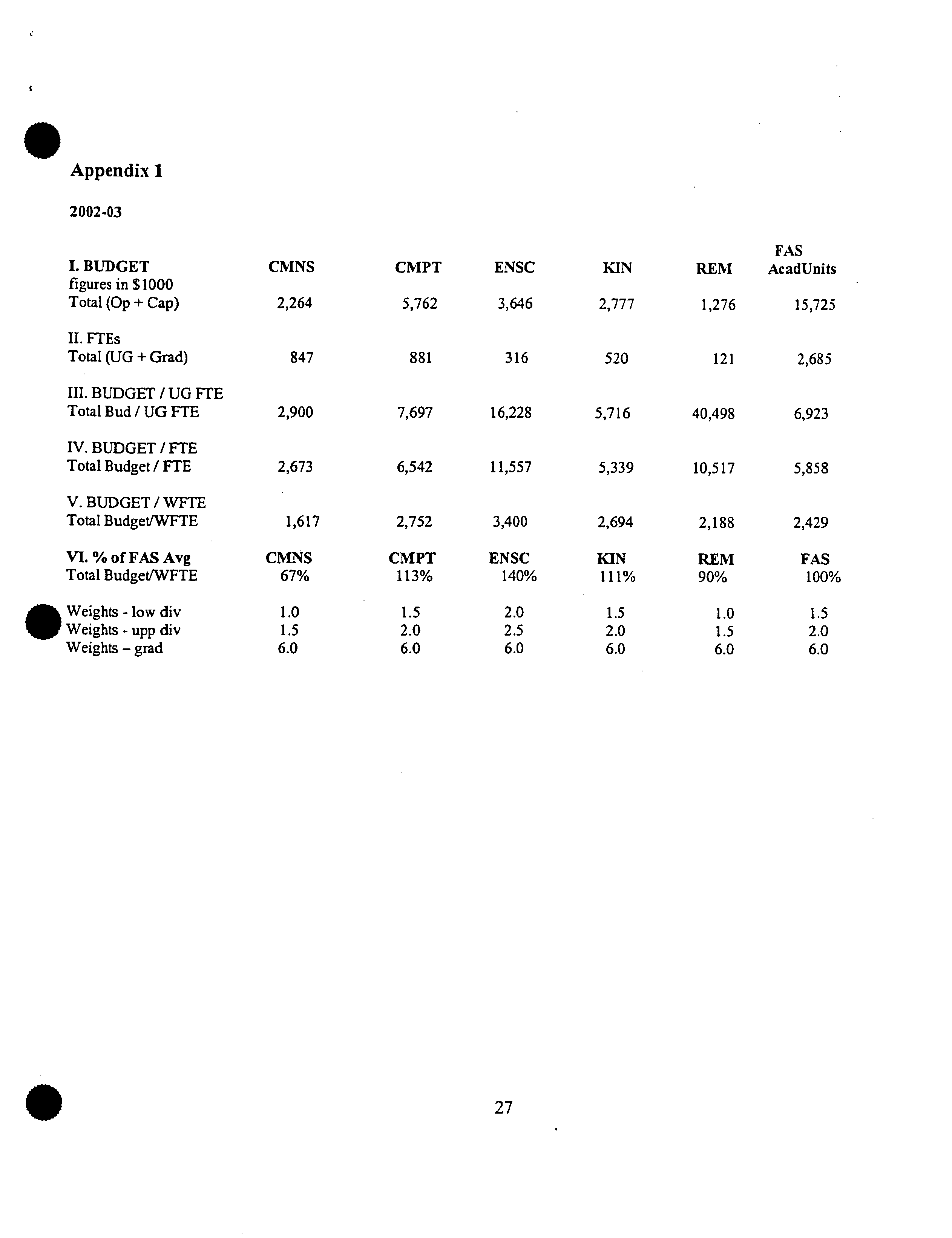.
S.04-26
SIMON FRASER UNIVERSITY
Senate Committee on University Priorities
?
Memorandum
TO:
Senate
?
FROM: Bill Krane
Acting Chair, SCUP
Acting Vice President,
Academic
RE:
School of Engineering Science ?
DATE: March 18, 2004
Faculty of Applied Sciences
External Review
The Senate Committee on University Priorities (SCUP) has reviewed the
External Review Report on the School of Engineering Science together with the
response from the School and comments from the Dean of Applied Sciences.
Motion:
That Senate concur with the recommendations from the Senate
Committee on University Priorities concerning advice to the School of
Engineering Science on priority items resulting from the external review as
outlined in
s.04-26
The report of the External Review Committee for the School of Engineering
Science was submitted on June 16, 2003 following the review site visit in April
2003. The response of the School was received on October 1, 2003 followed by
that of the Dean of Applied Sciences on February 23, 2004.
SCUP recommends to Senate that the School of Engineering Sciences and the
Dean of Applied Sciences be advised to pursue the following as priority items:
Undergraduate Program
SCUP recognizes that issue of leaves of absence of Faculty in the School have
been addressed to ensure that the number of faculty that are away
simultaneously do not impact the teaching or research capacity of the School in a
S
negative way.
0
CM
MM
Undergraduate Laboratories
SCUP recommends that the School determine its capital expenditure needs for
the next three years and investigate various sources of funding with the Dean.
TA Support
SOUP recommends that the TA Support levels be monitored as enrollments
increase to ensure their adequacy in meeting acceptable standards.
Biomedical Engineering Initiative
SOUP recommends that the School fully investigate the market need before
establishing an undergraduate degree in Biomedical Engineering.
Communications Program
SCUP is pleased to hear that additional resources have been allocated to the
Communication Program of the School to address strengthening it and ensuring
that it meets the demands of the growing enrollment. The School should proceed
with its plans to appoint a new dedicated communications skills instructor.
Comment on Course Weights
SOUP noted that the weighting of Engineering Science courses is currently
equivalent or superior to those of the Department of Physics.
S
S
C. ?
B. Lewis
M. Saif
G. Nicholls
J. Waterhouse
UP 04-011
MEMORANDUM ?
SIMON FRASER UNIVERSITY
S
?
FACULTY OF APPLIED SCIENCES
DATE:
I9 FEBRUARY 2004
TO:
?
Bill Krane, Associate VP Academic
FROM:
Brian Lewis, Dean, Faculty of Applied Sciences
RE: ?
External Review - School of Engineering Science
The external review of the School of Engineering Science (ES) occurred in the middle of a
period of great change for the School, the results of which have yet to entirely fall out, including
the DTO initiative, the Surrey initiative, and planning a new building. Long a relatively small,
elite program, Engineering Science is expanding its undergraduate and graduate programs,
planning new spaces and considering new initiatives. The review reflects some of the
uncertainty of the period, and while I generally find the recommendations appropriate, some I
do not support.
Recommendation: The number offaculty taking leave of absence, or sabbatical leave,
simultaneously, shall not exceed XX faculty members in each area of concentration and it shall
not exceed more than a total
of
YYfaculty members in the entire School.
This is reasonable practice. It requires active management and leadership, whether or not a strict
policy is written.
Recommendation: We recommend that a permanent line item in the budget of the School be
established to fund the acquisition, replacement and maintenance
of
the School's capital
equipment needs.
This recommendation is in line with normal business practice at some universities, and many
companies. However it is not now the established practice at Simon Fraser University. The
high quality of the ES program depends upon access to appropriate teaching and laboratory
equipment. We have been addressing the capital needs of the ES program through a
combination of major one-time allocations, and by increasing the DTO budget flowing to ES at
the Faculty level. A portion of the DTO funds can be budgeted by ES for recurring capital
costs. While this has worked in the short term, it is not clear that it will be adequate over the
long term.
Recommendation: The course weighting for Engineering Science be adjusted, to be more in
line with that of the courses in the Department of Physics.
This is the current practice. The standard weighting for Engineering Science and Physics at
both the upper division and the lower division is equivalent. These weights derive from the
Council of Ontario Universities, and are used throughout the university system in B.C.
concerned that as it grows, funding per weighted FTE be maintained at a level whiF
a
delivery of a high quality program. This will continue to be monitored, and adjust
to DTO allocations if justified.
. ?
Recommendation: The distribution
of
resourcesfor TA support be adjusted, refleting
needs of
the School and the intent
of
the DTO initiative
of
increasing substantially
education in Engineering Science at SFU.
?
\
Vice PTeSdt
\.
AcADEMIQ,
I
h.
As undergraduate and graduate enrollments now increase, it is necessary to provide adequate
funds for teaching assistant support. As the report notes, this has been addressed and will
continue to be addressed throu
g
h DTO allocations and premium fees.
Recommendation: We recommend that the University proceed with due diligence in its
initiative of establishing an undergraduate degree program in biomedical engineering by
devising a thorough marketing plan, which addresses the following questions:
The program proposal will be reviewed externally, and the questions raised in the external
review are important ones to ask.
Recommendation: Due to the increased student load brought about by the DTO initiative, all
incoming students should be screened for communication skills. Those in need of additional
skills should be required to take part in the Communication Program of the School while all
other students should be exempt from the one-on-one program. Furthermore, the school
needs to implement measures which ensure the long-term continuity and health of the
program. This program needs to be able to stand on its own, independent of individual
champions who run it.
The Communication Program of the School of Engineering Science has been recognized as an
important asset by the students and by industry. The Communication Program ought not be
considered a remedial program but should continue its tradition of providing enriched
communication skills for all ES students. In fact ES is now expanding communication faculty
to maintain the quality of the program.
Recommendation: A long-term solution to the Faculty Retention Fund should be articulated as
soon as possible with due consultations with the units affected.
The committee seems to have confused issues of market differential and retention fund in the
report. The issue of market differentials for ES and CS (School of Computing Science) is
contentious. The levels have been set by Academic Relations and this needs to be discussed
within the wider context of market differentials at Simon Fraser University.
Other issues raised by the Committee
The configuration of a University Faculty is always a combination of historical and conceptual
factors. Conceptual factors are strong in the case of the Faculty of Applied Sciences: all six
schools are in applied disciplines; at the centre resides a strong core of technology and
information technology research, development and teaching. The Faculty provides an
opportunity for a synergistic approach to technology in multiple areas of application:
technology in contexts of information, systems and controls, security, communication, health,
environment, new media, etc. This can bring extra value to ES, providing an opportunity for
interdisciplinary teaching, research collaboration and growth in new areas.
The Surrey initiative was a major endeavor of the Province and the University. This has been a
complex process, requiring the resolution of profound academic, administrative and human
resource issues in a very short time frame. It meant balancing the interests of many parties. ES
has not been enthusiastic about this initiative, nor the development of possible joint programs with
SlAT (School of Interactive Arts and Technology) and CS at Surrey. Nevertheless, ES has begun
to consider Surrey as a site for the development of accredited ES programs, and the
implementation of a summer bridging opportunity for Surrey students into ES.
The School is to be congratulated on its willingness to make adjustments to its teaching
program, such as the introduction of the general majors program. Engineering Science is
developing a proposal for a new core program in mechatronics as well as a program in
biomedical engineering in conjunction with Kinesiology
•
?
As noted in the review, there is room for improvement in grants and contracts brought in, and
faculty have been in the habit of going on leave or buying out teaching. Further there is a need
to give more priority to the graduate program. The ES faculty is undergoing substantial renewal
and I am confident that ES will move ahead in these areas over the next few years.
1Jk4J&wq
Brian Lewis
Dean
Faculty of Applied Sciences
BL/lc
cc: M. Sail, Director, School of Engineering Science
0
SOUP 04—Oil
1
S
School of Engineering cuence
External Review Response
Mehrdad Saif, Director?
Jacques Vaisey, Associate Director
?
October 10, 2003
-.
'flrr
Summary
The School of Engineering Science underwent an external review of its programs
from April
9_11th
of this year. We received the report of the review committee on
June 24
1h
and it has since been made available to all faculty and staff in the School.
In general, the School is content with the review and believes that most of the
criticisms and concerns are valid. In its report, the committee made a number of
recommendations on what it felt were the key issues facing the School. In the
remainder of this document, we quote the issues raised by the committee and then
discuss the School's position, sometimes bringing forth additional information that
may have been overlooked during the review visit.
Recommendations
As directed by the University, the review committee formalized its most
important concerns as a series of recommendations for action. We now address these
recommendations in the order in which they appear in the report.
Recommendation 1
The number offaculty taking leave
of
absence, or sabbatical leave, simultaneously, shall
not exceed XX faculty members in each
of
the areas
of
concentration and it shall not exceed
more than a total
of
YYfaculty members in the entire School.
We agree with this recommendation and it is the policy of the current Director to
not approve sabbatical leaves where there are doubts as to whether the School's
teaching and academic needs can be met or where there are already 2 members
away from a group or 6 from the entire School. We are currently considering
whether a policy needs to be formalized.
0
Recommendation
2
We recommend that a permanent line item in the budget of the School be established to
find the acquisition, replacement and maintenance of the School's capital equipment needs.
This recommendation has our strong support - indeed, we have discussed this
point with the Senior Administration many times over the years in efforts to get a
recurring budget allocation. The same issue was also identified following our last
Accreditation review by the Canadian Engineering Accreditation Board in 2000. As
a result, we ask that this issue be addressed by the University administration.
Recommendation
3
The course weighting for Engineering Science be adjusted, to be more in line with that of
the courses in the Department of Physics.
Engineering is an experimental and practical profession that needs laboratories
and thus requires more resources per FTE than sister FAS Schools such as
Computing Science and others. The current weightings for courses in FAS according
to the Analytical studies are:
"In Applied Sciences, lower division and upper division
FIE's
receive a weight
of 2.00.
Graduate
Masters, Qualifying and Special
FTE's
receive a weight
of 4.00.
PhD's receive a weight
of 6.00.
There
are some exceptions to these weights: Lower-Division Communications courses receive a weight of
1.00. All
lower division correspondence courses receive a weight of
1.00
and all upper division
correspondence courses receive a weight
of 1.50".
Source: Office of Analytical Studies -Annualized
Undergraduate Enrollment Report, Table 2; SFU Factbook, Table D-16, WFE Database, 55C6300.
These numbers do not reflect the real differences in the program costs, which
should be the goal of the WFTE concept. In recent years, and particularly for DTO
funding allocations, similar inaccurate course weighting has been used to make
important resource allocation decisions to the detriment of Engineering Science.
We agree with the reviewers that Physics is probably the one Department that
most closely matches us in terms of program requirements and costs; however, to be
fair, this comparison needs to be made on the basis of cost per program
major
FTE,
rather than on pure FTE numbers, which can be hugely inflated by often low cost to
run 1 year service course enrolments in some departments.
Recommendation 4
The distribution of resources for TA support be adjusted, reflecting the needs of the
School and the intent of the DTO initiative of increasing substantially graduate education in
Engineering Science at SF11.
We have long recognized that our School is poor in terms of TA resources and
we would welcome any initiative to increase our support from the University in this
area. That said, we have allocated all of our share of the tuition fee premium
charged to Engineering Science undergraduate students, as well as significant
monies from our DTO funding, to bolster the TA budget. We remain of the firm
opinion, however, that our past problems with low levels of TA funding can not and
should not be solved with DTO funds. DTO funds are barely enough to cover the
cost associated with the intake of DTO students.
In addition, the School is currently considering ways in which portions of the
TA budget can be used to recruit students to SFU through promises of TA positions.
This issue is complicated, however, by our reluctance to assign teaching
assistantships before the candidate has been assessed for English language
competence and general communication abilities.
Note that we have recently adjusted our TA allocation procedures to conform to
the T.S.S.U. framework agreement. Graduate applicants are considered before
undergraduates ones when making TA assignments, with a very strong rationale
required before an undergraduate student can be hired. In the past, we allowed
professors to request an undergraduate TA if they simply judged them the better
candidate. This change is not popular with many ENSC undergraduates, who often
prefer their peers as TAs; however, it has resulted in better and more reliable
support for graduate students.
Recommendation
5
We recommend that the University proceed with due diligence in its initiative of
establishing an undergraduate degree program in biomedical engineering by devising a
thorough marketing plan which addresses the following questions: What is the pool of high-
school students interested in such a program? What are the opportunities offinding co-op
jobs for students in such a program? Is there a natural fit at SFU (where there is no medical
school nor a teaching hospital) to establish a high quality program in biomedical
engineering? What is the job market for graduates from such a program? In order to increase
the opportunities for the graduates of the program under consideration, we strongly
recommend that it be revised so that it may, if desired by the students, serve as a pre-med
program, requiring only four academic years. Finally, we strongly recommend that the
School engage consultants from successful undergraduate biomedical engineering programs
(e.g., Duke, Marquette) for guidance in this endeavour.
Engineering Science is proceeding with due diligence on this matter. As of this
writing, the School's Undergraduate Curriculum Committee is nearing completion
on a draft Biomedical curriculum. Once complete, this document will be sent to
three external reviewers for comments. Our intent is then to integrate these
comments into the proposal and then bring it to the Faculty level, where it will be
discussed and externally reviewed a second time.
Recommendation 6
Due to the increased student load brought about by the DTO initiative, all incoming
students should be screened for communication skills. Those in need of additional skills
should be required to take part in the Communications Program of the School while all other
students should be exempt from the one-on-one program. Furthermore, the School needs to
implement measures which ensure the long term continuity and health of the program. This
program needs to be able to stand on its own, independent of individual champions who run
it.
To some extent, this recommendation will be dealt with at the University level,
through the (proposed) adoption of the "Language Placement Index" test for
admission screening as recommended by the University Curriculum
Implementation Task Force. At another level, however, this statement misses the
point. The job of our Communication Skills program is not simply to teach the
students generic skills covered in the high-school curriculum, but to teach them to
express themselves as Professional Engineers, including style conventions and
standards of discourse that are unique to Engineering. All of our students need to go
through this program regardless of how well they have done in high-school courses
such
as
English-12.
The reviewers are correct, however, that we do need to implement changes to
ensure the long-term health of the program, especially in light of our recent growth.
As a first step in this direction we have successfully obtained funding for 40% of a
new Communications Skills instructor through an application to the "CFL to FTE
Ratio Fund". We are still searching for the remaining 60% of this position and in the
near future we will be making a proposal to the Dean and the VPA that University
fund this using the "house" portion of the DTO funding envelope. In addition to our
plans to hire an additional Communications Skills instructor, we are happy to report
that our application to the Strategic Initiative Fund for development of online
material for Engineering Communication courses using WebCT has just been
approved. The result is that we have received $20,000 in non-recurring funding for
2003/04, plus a subsequent $10,000 in 2004/05.
We are of the opinion that the hiring of a new instructor .together with funding
for online delivery of some components of the Communication Skills Program will
address the concerns of the reviewers.
S
S
Recommendation 7
A long-term solution to the Faculty Retention Fund should be articulated as soon as
possible with due consultations with the units affected.
This
issue
is an important one in the School. Although the faculty were very
pleased that the University was at long last able to address serious market
inequalities with the Retention Fund, there remains a great deal of concern
regarding how this matter will be resolved in the long-term. We feel that it is critical
for the University to stabilize the situation by finding a permanent solution as soon
as possible, as has been done in many other universities in Canada.
Other Concerns
In addition to formal recommendations, the committee also expressed a number
of concerns in the body of their report. We now address these concerns in the order
of their appearance in the report.
Concern 1
(from Section 2b)
Current external research funding generated by the faculty in the school is average or
perhaps below average at best in comparison to the peer groups in Canada. For example,
NSERC research grants (Discovery Grants) data indicate that only 25%
of
the faculty have
grants higher than the average grant size awarded by the appropriate grants selection
committees (NSERC GSC# 334, 335), 50% have below average grants (some, significantly
below average) and the remaining 25% do not hold a NSERC grant [new members (2) were
excluded in the comparison].
In recent years, the external research fundirg held in our School had dropped,
largely due to the number of faculty of leaves and sabbaticals. Most of these faculty
members have now returned to SFU and they are working at rebuilding the funding
base for their research programs. In addition, we expect that our new faculty will be
successful at competing for funds and that this will contribute healthily to our grant
numbers
In a proactive move, we have identified improvements in our graduate program
as a priority for the School and we will doing our DTO related faculty hirings with
this in mind. The bottom line is that funding is tied to research activities, which is in
turn tied to our ability to attract and train good quality graduate students.
Improvements in the cohesion, depth and quality of our graduate programs will
S
result in better research and better research funding.
5
An additional factor that has affected funding opportunities is the temporary'
recession in the high-tech sector. Industrial funding in areas such as
Telecommunications, Microelectronics and Computer Engineering is currently well
below historical norms. As this sector recovers, we expect to see increased research
funding flowing to our School.
Concern
2 (from Section 2b)
The DTO initiative provides a doubling of resources of TA support for the School (from
$80,000 to $160,000 annually). To support 150 graduate students, substantialfrnding will
have to be raised from external sources. It has been suggested by several of the faculty
members that some of this funding should perhaps come from the 40% of the DTO funding
that presently goes to the University. These faculty point out that at UBC, only 20% of the
DTO funding is taken by the University. However, in most of the research intensive
Engineering Faculties in Canada, researchers, through the external funding, carry a
substantial fraction of the student-support load. This culture/commitment was not
uniformly visible to us at the School of Engineering Science. Perhaps some of the DTO
funds could be used to provide incentive (matching funds) to the School to establish a culture
Of an externally funded student-support system. This is particularly achievable in the
Engineering Science, where the faculty teaching load is not heavy.
The above statements need clarification:
1.
In 2002/ 03 the School was given a TA budget of $88,969, but actually spent
$196,210 on TAs by supplementing the budget using its entire share of the
Premium Fund together with a portion of our DTO allocation. This fiscal
year our TA budget was $92,528 and we have so far spent $132,322 on TAs.
These numbers clearly demonstrate that our TA budget is inadequate
regardless of DTO growth.
2.
In 2002/03 ENSC had about 110 graduate students of which 86 were full time
students. By and large our part time (M.Eng.) students do not require
financial support as they are already employed in industry. We do expect,
however, to see an increase in the number of full time graduate students and
realize that this will require substantial external funding. We are also
confident that alongside our enrolment increase, the amount of external
funding coming into the School will also increase in the next few years. This
growth is expected since, as previously mentioned, a number of faculty
members are now back from leaves and are applying for new grants. We will
also see a direct increase in the level of external research support as new
faculty are hired to support the DTO growth. These phenomena are already
evident to some extent since our count of full-time graduate students grew by
over 25% this fall.
3. Contrary to the concern of the reviewers, Engineering Science has had a
culture of funding many graduate students purely with external research
support from the day the student enters the program. This practice is in
contrast to that in place at many engineering schools where by and large
every graduate student is supported as a TA through at least their first year
of graduate studies. It is this issue that may have been expressed by some of
our faculty members and may have been misinterpreted as a "culture" or lack
of "commitment" to fund graduate students through external research funds.
Finally, we are in favour of the suggestion to use some of the "house" portion of
the DTO monies, perhaps in the form of TA support, to match externally funded
support of graduate students.
Concern 3
(from Section 3c):
Since the proposed undergraduate degree program in Biomedical Engineering will
require substantial resources, and in view of some of the uncertainties raised above, it is
natural that the School consider also other logical alternatives. For example, why not expend
some of the new resources from the DTO initiative on strengthening the existing areas of
•
concentration (making the Communications Group a world leader in wireless
communications systems; expanding and strengthening the Microelectronics Group to
become an important player in semiconductor electronics on a global level; and nurturing the
Systems Group to parity with the other two groups)? Why not consider an undergraduate
degree program in computer engineering (which could be implemented with modest
additional resources and could serve as a natural conduit for cooperation and interaction
between the School and Computer Science)? In view of recent developments with TechB,
similar questions can be asked about Multimedia.
The School's strategy has been to use the DTO resources to strengthen the
current areas of program offering and to start a joint and somewhat specialized
program in Biomedical Engineering. As the reviewers have suggested, starting a
large-scale Biomedical Engineering program will require substantially more
resources than are currently available. It is for this reason that we have decided to
start a program with a somewhat narrow focus that will draw heavily upon
available expertise in the School of Engineering and Kinesiology. Having said this,
in hirings over the past year, the School has attracted two faculty members in the
area of Microelectronics and one each in Communications and Systems. We are
currently trying to hire an additional Communications person in the area of
Networked Multimedia. Furthermore, we believe that we have enough faculty
members in the Communication Group to be a serious player in wireless
communicationssystems at both national and international levels.
In addition to the above, the School has been actively proposing to grow further
by taking a larger share of the DTO funding envelope. We believe that it is possible
to exploit the high demand for Engineering by offering more comprehensive
programs in Biomedical Engineering and the Microelectronics/ Computer
Engineering! Nanotechnology areas.
Concern 4
(from Section 3e)
While the faculty and students in the School are responding well to the Dean's directives
(regarding diversity and equity),
the intensity of efforts and pro-activeness could easily be
increases. In this respect, SFU is behind other Engineering Schools in Canada. They need to
connect up to the National networks (e.g. Women in Engineering Committee of Canadian
Council for Professional Engineering) and other professional initiatives.
Although it is always possible to improve in this area (at least as long as women
are a minority of our undergraduate population), the School has been actively
working at improving the environment for women. As an example, we have
recently hired two additional women faculty, although one of these recently
declined her position eight months after accepting it. Furthermore, In October 2002,
the Dean of Applied Science asked the Schools of Engineering Science and
Computing Science to develop plans to increase the proportion of women students
in their schools. An ENSC Equity Committee was formed in late 2002 with faculty,
staff and student representatives to develop such a plan. The Committee at this
point
sending
has
it
made
to the
a
Dean.
draft of the plan available to the School for comments before
?
is
The reviewers' comments in this area although generally helpful, are also
inaccurate in spots. They suggest that typically 20-30% of engineering students
nationwide are female; however, data from the Canadian Council of Professional
Engineers (CCPE) suggests that the 30% number is too high for engineering in
general, and that the 20% is too high for electrical and computer engineering (the
closest match to ENSC) . The review report suggests ENSC should connect with
national networks; however ENSC is already connected to such networks through
the FAS Equity office, and has been so since 1997. Copies of all of our hiring
announcements are sent to the NSERC Women's Chairs, to DAWEG, and to several
other groups.
0
Concern 5
(from Section 4a and Section 5):
It is the view of the present committee that as long as the School of Engineering Science
is part of the Faculty of Applied Sciences, with its present faculty make-up, there will be
justifiable lingering problems in faculty morale and this will impede the progress of the
School in realizing its lofty goals.
The confluence of the DTO Initiative and the Surrey Initiative and the establishment of a
Institute of Health Sciences, along with the convictions of the faculties of the School of
Communication and the School of Engineering Science that theirs is not a natural fit within
the Faculty of Applied Sciences, affords leadership at SFU with a unique opportunity for
structural changes within the University which should enable these schools to reach more
easily their next levels of excellence.
There is certainly strong support within the School for addressing the above issue. It
is true that the School of Engineering Science, the Faculty of Applied Science and
indeed the University as a whole are all evolving. The University is about to embark
on creating a new Faculty of Health Sciences, and FAS just recently expanded by
taking on the School of Interactive Arts and Technology in Surrey. Clearly, these
•
changes will have a large impact on our School. For this reason, it seems natural and
timely for the School, the Faculty, and the University to seriously consider whether
the existing structures serve the needs of the various schools and their students in
an optimum fashion. We realize that this study is a major proposition and one that
requires careful discussion and planning. However, we feel that restructuring is an
important issue that needs to be given serious consideration. As such, the School
plans to strike a committee to further discuss and examine the placement of the
School in FAS. At the same time, we would welcome any dialogue with the senior
administration on this matter.
SCUP 04- 011
EXTERNAL REVIEW: ?
SIMON FRASER UNIVERSITY
?
SCHOOL OF ENGINEERING SCIENCE
?
2003
Vice Predr:t
?
ACADEMIC
Submitted by:
Dr. Sujeet Chaudhuri , Committee Chair
?
Dr. Ouassima Akhrif
?
Dr. Anthony N. Michel
University of Waterloo
?
Université de Québec
?
University of Notre Dame
0
Canada
?
Canada
?
U.S.A.
S
[1
.
TABLE OF CONTENTS
1. ?
Introduction ?
..............................................................................................................................
1
2. Present Status of the School.....................................................................................................
2
a) The Undergraduate Program.........................................................................................
2
b) The Graduate Program...................................................................................................
5
c) Faculty and Research.....................................................................................................
9
i) Communications Group.....................................................................................
9
ii) Microelectronics Group....................................................................................
10
iii) Systems Group ................................................................................................
11
d)
?
Infrastructure ..................................................................................................................
11
i) Departmental Assistant and Support Staff
........................................................
11
ii) Technical ?
Staff .................................................................................................
12
iii) Undergraduate Laboratories............................................................................
12
iv) Research Laboratories.....................................................................................
13
v) The Library ....................................................................................................... 14
vi) The Center for Systems Science (CSS) ............................................................
14
3. Future Directions of the School................................................................................................ 14
a) The DTO Initiative.......................................................................................................
15
b) The Biomedical Engineering Initiative........................................................................
17
c) Alternative Initiatives and Other Issues........................................................................
19
d) Communications Component of the Undergraduate Program.....................................
19
e) Welcoming Women Initiative.......................................................................................
21
0
Market Differential Fund Initiative...............................................................................
22
4. Other Issues of Importance.......................................................................................................
23
a) The School's "Fit" within the Faculty of Applied Sciences.........................................
23
b) The Surrey Initiative.....................................................................................................
24
5.
Some Concluding Remarks.......................................................................................................25
Appendix1.....................................................................................................27
0
.
1. Introduction
During its twenty year history, the School of Engineering Science at Simon Fraser
University (SFU) has made significant contributions in educating competent engineering
professionals, in contributing to knowledge through basic and applied research, and in rendering
valuable service to professional societies and the community in which the School resides. At this
juncture, made possible by the "Double the Opportunity" (DTO) initiative, the School has an
unusual opportunity to raise its sights to an even higher level of excellence, especially in
graduate education and research.
In this report, we will first elaborate on the present status of the School, including the
effects the DTO initiative has had thus far. Next, we will comment on future directions the
School might take, in light of the DTO initiative, in order to reach that next level of excellence.
In the third part we will address some issues which in our opinion the University needs to
address in order that the School may reach its full potential. Finally, we summarize our findings
and offer some suggestions.
The observations and recommendations contained in this report are the result of a review
of materials made available to the committee members by Simon Fraser University and findings
made by the committee during a three-day visit to the- SFU campus (April 9 - 11, 2003). In view
of the brevity of this visit, it may very well be possible that the committee may have missed
some aspects of importance and in some instances, may have gained imperfect impressions. For
this we apologize.
We would like to take this opportunity to express our gratitude to Ms. Laurie Summers,
Director Academic Planning, for the meticulous organization of our visit to SFU. Hospitality
and co-operation extended by the colleagues at the VP Academic Office and at the School of
Engineering Science facilitated our work immensely. We gratefully acknowledge their support.
We would like to make special mention of Dr. Robert Frindt, internal member of our committee,
for providing very valuable insight on the culture, history and various intricacies of operations at
0
the Simon Fraser University.
1
2. Present Status of the School
Engineering Science at Simon Fraser University is one of the five schools in the Faculty
of Applied Sciences. The other four include the school of Computing Science, Kinesiology,
Resource and Environmental Management and Communication. The School of Engineering
Science administers undergraduate and graduate programs leading to the BASc, MASc (MAP,
MEN), MEng, and PhD degrees in Engineering Science. The University operates on a trimester
system. The fall and spring terms are 13 weeks each while the summer term is somewhat shorter.
Prior to fall 2002, the School's annual intake of Year I undergraduate students was 84 full
time equivalents (FTE's). Beginning with fall 2002, when the DTO initiative took effect, the
School was mandated to accept 136 FTE's annually. Also, under the DTO initiative, the current
number of 90 FTE graduate students (excluding MEng students) is to be increased to a projected
150
FTE ' s. For each new student, Simon Fraser University receives $12,000 operating funds for
each undergraduate and $20,000 for each graduate increment from the provincial government.
a) The Undergraduate Program
It takes 150 credits to earn a BASc in Engineering Science at SFU. The program is
nominally spread over five years, since every student is required to take part in the co-op
program (involving a minimum of three co-op terms).
The first two years of the undergraduate program are common for all students.
Thereafter, the students may specialize in one of four areas: Electronics, Computer Engineering,
Systems Engineering, or Engineering Physics.
A distinctive feature of the undergraduate program is that it operates on an open-lab
basis, with all teaching laboratories available 24 hours a day. On one hand, this system provides
great flexibility for the students in conducting their work; on the other hand, there are occasions
when students have to compete for desirable time slots to do their experiments. Generally, the
students like the open-lab system.
Another distinctive feature of the undergraduate program is its (seven credit)
Communications Component, administered by two Senior Lecturers with the help of TA's. The
?
is
2
S
various parts of this program involve public speaking, technical writing, group presentations,
preparation of reports, and the like.
Prior to fall 2002 (before the DTO initiative took effect), the School ran essentially an
honours undergraduate program: all students had to maintain a minimum of a 3.0 grade point
average and a thesis (worth 12 credits) was a degree requirement.
Beginning fall 2002, with the increased number of undergraduates, the School was forced
to adopt a two-tier system, involving an honours program, with the same requirements as
described above, and a "regular" undergraduate program. The latter does not involve a thesis
requirement and students need to maintain only a 2.4 grade point average.
The School invests substantially in a well-run co-op program. Of the 35 co-op
coordinators at SFU, three are assigned to the School. Students usually alternate between co-op
and study terms; however, sometimes there is an eight month placement. The school has a
50%-
•
70% co-op placement rate. As mentioned earlier, a minimum of three co-op terms are required
for the undergraduate degree in engineering science.
There is a culture in the School which does not put great pressure on students to finish
their degree requirements within five years. One of the reasons given for this is the co-op
program which enables students to take more than the required number of co-op terms. Another
reason given is the great flexibility of the academic program. However, many students do not
complete their degree requirements in a timely manner because they frequently fall out of a
prescribed course sequence, having then to wait until the next time the (required) course is
offered again.
Graduates from the School usually do not go on to graduate school. There seem to be two
primary reasons for this: they are in high demand by industry; and the culture of the place
(meaning, they are not encouraged by the faculty to pursue a graduate degree).
Most of the students in the School are from the greater Vancouver area, i.e., this is a
commuter school. A consequence of this is that there is not much socializing between the
S
faculty, between the students and between the staff. During the evenings, not many people are at
the School.
3
The undergraduate students that we talked to (two males, one female) were bright and
articulate. They like the education that they are receiving in the School. They came to SFU
because of its reputation. They like their professors, the TA's and the curriculum. Their
comments on the Communications component of the curriculum (technical writing, etc.) were
especially positive. However, they were very apprehensive about the effects that the DTO
initiative may have on their program of study.
The effects of the DTO initiative, both positive and negative, are increasingly being felt
and anticipated. In the following, we elaborate on the more important of these.
i)
Since the School now operates a two-tier system, it is no longer an elite school for
undergraduates. There are fears among some of the faculty that the quality of students will
suffer. As a consequence of the DTO initiative, Engineering Science at SFU will be transformed
from a small school to a larger school. One of the faculty opined that "there are some large elite
engineering schools in Canada, but this School will not be one of them".
On the other hand, the availability of the non-thesis option will cut down on the time
required for graduation and it will reduce the attrition rate of the undergraduate students in
Engineering Science.
ii)
There are conflicting views on the impact of the DTO initiative on the undergraduate
teaching laboratories. Some feel that more students will make it more than ever necessary to
operate open labs, while others feel that some of the laboratories would no longer be run on an
open-lab basis. Equally, there are concerns about the amount of equipment that will have to be
available to teach so many students. There will be an extra technician available as a consequence
of the DTO initiative. However, it is felt that the School will not be able to run the laboratories as
before and that there will be increased competition amongst the students for lab space,
equipment and desirable time slots.
iii)
As a consequence of the DTO initiative, it is anticipated that class sizes will increase.
However, there will also be multiple offerings of courses which will shorten the time required for
graduation as there will be more flexibilities for the students to stay with the prescribed course
sequence.
LI
4
iv)
The Communications component of the undergraduate program is severely impacted
by the DTO initiative. We will comment on this in greater detail at a later point.
v)
It will be more difficult to find co-op positions for the students.
vi)
As a consequence of the DTO initiative, it is projected that the School will be slightly
better of in terms of space.
vii)
The Physics Department was able to hire an additional Lecturer to accommodate the
increased number of students due to the DTO initiative.
Before proceeding further, we wish to comment on an issue which impacted significantly
both the undergraduate and the graduate programs of the School and which should be of great
concern.
In
1995 -
1996, an excessive number of faculty went on leave of absence. This has had a
serious impact on course offerings in both the undergraduate and the graduate programs. There
are indications that the administration was either unable or unwilling to prevent this. In the
interests of all concerned (faculty and students), so that this may not occur again, it may be
advisable to modify the bylaws of the School's governance document, along the following lines.
Recommendation:
The number of faculty taking leave of absence, or sabbatical leave,
simultaneously, shall not exceed XX faculty members in each of the areas of concentration and it
shall not exceed more than a total of YY faculty members in the entire School.
b) The Graduate Program
It takes typically three years to complete the MASc degree requirements in Engineering
Science and four to five years in addition, to obtain the PhD. degree. The MEng degree in
Engineering Science requires seven courses, with a couple of these prescribed, plus a project.
Students studying towards these degrees specialize in one of the three strengths of the School:
S
r
Communications, Microelectronics, or Systems.
The graduate student enrollment of the School has been stagnant for some time.
Currently, there are a total of 90 full time graduate students plus a number of MEng students.
There are only 18 PhD students at this time. More than half of the students are international
students. Majority of the students are either unfunded or poorly funded. One of the
consequences is that the students admitted come generally from the bottom 1/3 of the
applications pool.
The reasons for the low graduate program enrollment are primarily a lack of funding for
support. Of the 90 full time graduate students, only
35%
receive funding for support from the
School. The remaining students are self-supporting. Another factor which affects graduate
student enrollment is the absence of tuition waivers. All students (domestic as well as
international) pay the same amount of tuition, $3800 per year. This puts the School at a
competitive disadvantage with other local institutions that offer waivers (e.g., UBC has decided
to waive tuition fees for all PhD students).
?
0
As mentioned earlier, several of the senior faculty were on leaves of absence in 1995-
1996, with the consequence that fewer externally funded RA positions were available for
graduate student support and fewer graduate courses were being offered. The effects of these
leaves on the graduate program are still being felt. Current external research funding generated
by the faculty in the school is average or perhaps below average at best in comparison to the peer
groups in Canada. For example, NSERC research grants (Discovery Grants) data indicate that
only
25%
of the faculty have grants higher than the average grant size awarded by the
appropriate grants selection committees (NSERC GSC# 334, 335), 50% have below average
grants (some, significantly below average) and the remaining
25%
do not hold a NSERC grant
[new members (2) were excluded in the comparison].
According to the Dean of Graduate Studies, the Arts Faculty, the Education Faculty and
the School of Communication are all doing relatively well in terms of the number of grants
received and amount of funding per faculty member. Within SFU, the School of Engineering
Science is about in the middle in external funding. Engineering Science is not doing as well as
S
the Science Faculty. (In Science, all full-time graduate students receive support.) Furthermore,
the faculty of the School does not seem to be doing very well in securing external research
support from industrial sources. (However, the outside activities of the faculty members are not
reflected in their documentation.) Consequently, the number of RA's available for graduate
student support in the School has been low.
There are a number of graduate fellowships of $5200 per term available for PhD students
which are awarded one term at a time. The University has a total of 400 of these and the number
of fellowships assigned to a School is determined by the School's number of graduate students
relative to the total number of graduate students at SFU. (MEng students are not included in this
count.)
The TA budget of the School ($80,000 annually prior to the DTO initiative and $160,000
thereafter) is relatively small, when compared, e.g., to Computer Science, Mathematics, or
•
Physics, because the School is not involved, in extensive teaching of service courses.
Consequently, the number of TA positions available for graduate students is on the low side.
This situation is exacerbated, because frequently TA positions are assigned by some of the
faculty members to undergraduate students who are often preferred over international students
because of language problems. (The undergraduate students that we talked to seemed to prefer
undergraduate TA's as well.) Currently, the Teaching Student Staff Union has lodged grievances
concerning this issue. (According to some of the graduate students who we talked to, the
undergraduate TA's are frequently unprepared for the job they are expected to do.)
PhD students receive $5000/term as TA's. They work 15 hours a week and their duties
typically involve correcting papers and lab reports.
All three degree programs (MASc, MEng, PhD) are based on limited course offerings.
These courses are all taught in the evenings and there is tension between the MEng students and
the rest, since the former frequently would like more practically oriented courses. The choice in
courses is frequently limited and it can happen that an MASc or MEng student may end up with
• all courses in one field (e.g., communications).
The School of Engineering Science at SFU is a commuter school. A consequence of this
7
is that there is little interaction (including socializing) amongst graduate students, faculty and the
research groups.
Issues concerning the DTO initiative, both at the undergraduate and the graduate levels,
are resolved through committees. According to several faculty members, the Director of the
School has played a very positive role in these committees.
The DTO initiative will elevate the graduate program of the School to a new level of
excellence. All aspects of the graduate program will be affected (teaching, research, funding,
service) and the reputation of the School as a community of scholars will be enhanced. To
accomplish all this, will of course involve quite a few challenges. We elaborate:
i)
The DTO initiative demands a projected enrollment count of 150 FTE's plus the MEng
students. These numbers were imposed by the provincial government. Although there will be
increased resources, some of the faculty members are apprehensive about reaching this goal,
suggesting that it is too ambitious.
ii)
The DTO initiative provides a doubling of resources of TA support for the School
(from $80,000 to $160,000 annually). To support 150 graduate students, substantial funding will
have to be raised from external sources. It has been suggested by several of the faculty members
that some of this funding should perhaps come from the 40% of the DTO funding that presently
goes to the University. These faculty point out that at UBC, only 20% of the DTO funding is
taken by the University. However, in most of the research intensive Engineering Faculties in
Canada, researchers, through the external funding, carry a substantial fraction of the student-
support load. This culture/commitment was not uniformly visible to us at the School of
Engineering Science. Perhaps some of the DTO funds could be used to provide incentive
(matching funds) to the School to establish a culture of an externally funded student-support
system. This is particularly achievable in the Engineering Science, where the faculty teaching
load is not heavy.
iii)
With the resources provided by the DTO initiative, it will be possible to increase the
size
external
of the
funds
faculty
for graduate
of the School.
support
These
and research
new faculty
equipment.
members
Also,
will
because
be engaged
of these new
in securing
faculty
?
is
8
members, there will be additional graduate course offerings. This in turn will increase the quality
of research and it will make it possible for students to complete their degree requirements in a
timely manner. Further, the addition of the new faculty will not only increase the number of
graduate students in the School, but also the quality of these students. The School will overcome
many of its current problems that arise because of a lack of critical mass and the reputation of its
graduate program will be enhanced appreciably.
c) Faculty and Research
At two courses a year, the teaching load of the Faculty of the School of Applied Sciences
is quite reasonable and there should be ample time to secure external funding in order to sustain
a vigorous research program centred around educating graduate students. However, as mentioned
earlier, within SFU, the members of the School of Engineering Science is only somewhere in the
middle to below average in external grantsmanship and as a group they are not doing as well as
the faculty of the School of Science. Further, the School is not doing well in receiving industrial
support for research.
When classified according to research interests, there are three research groups in the
School. In the following we elaborate on these.
i) Communications Group.
Consisting of ten people, this is the largest of the three
groups. Three of the ten faculty members are new.
The real strength of this group is in wireless communication. The group feels that there is
a need of two additional faculty members with expertise in the communications network area. In
our view, they might also consider adding expertise in information theory and coding theory.
This group is one of the better funded groups in the School and there are pockets of
excellence with international stature within this group. Most of the research conducted by this
group is on the applied side.
A great deal of the instructional activities of the School fall on the shoulders of this
group. This is especially true in the case of the undergraduate program and the MEng degree
program.
S
There seems to be a reasonable level of interaction amongst various faculty members
within the Communications Group and also with people outside of the School (e.g., with people
from Computer Science). Also, there appears to be a high level of interaction between various
members of this group and industry.
Several members of the Communications group have rendered service to professional
societies by holding various editorship positions. One of the members of this group is a Fellow
of the IEEE.
Perhaps the greatest weakness of this group is that three of its members do not overlap
too well with the remainder of the group, although they overlap rather well with some people
outside of the School.
ii) Microelectronics Group.
This group consists of seven members, including one who
is on leave. As in the Communications Group, there are pockets of excellence in this group,
revolving around work in the semiconductor devices and fabrications area. This work takes place
in excellent facilities which are operated in conjunction with the Physics Department. In addition
to its strong interactions with members of the Physics Department, members of this group
collaborate also with people from the School of Kinesiology, with people from industry and with
teams outside the University at the national and international levels.
Four people of this Group have been at SFU for some time, one is a new hire, one is on
leave, and there is an offer out to another individual. One of the members of this group holds a
joint appointment in the Physics Department.
Collectively, the group offers an assortment of undergraduate and graduate courses in
microelectronics, giving the students hands-on experience in compound semiconductor
technology devices, silicon based microelectronic devices, and micro-machined devices,
components and systems.
The Microelectronics Group wishes to expand in areas related to "systems on a chip"
building blocks and high speed systems suitable for communication and signal processing. Some
of the faculty members of the Microelectronics Group do not believe that the needs of the group
will be addressed by the DTO initiative. They do not feel that the group is at a critical mass since
.
10
S
most of its members work in diverse areas and there is no cohesive plan for the group.
Because of the DTO initiative, it is anticipated that there will be an increase in the
teaching loads in several popular microelectronics courses. In our opinion, DTO is an excellent
opportunity for SFU to strengthen and materialize the full potentials of this group.
Past leaves and buyouts have hurt the graduate program in Microelectronics.
iii) Systems Group.
The Systems Group consists of seven people, including the Director
of the School. The group emphasizes applied research in robotics, control, biomedical systems
and in modeling and design of electromechanical systems. The various members of the group
have established working linkages with other programs and groups within and outside the
University. Collectively, the group offers undergraduate and graduate courses in the areas
described above. During the past few years and at this time, several major administrative
positions of the School have been and are being occupied by members of this group.
.
?
?
As in the other two groups, there are pockets of excellence in research in the Systems
Group.
This is perhaps the group with the most diverse interests in the School, with backgrounds
in electrical and mechanical engineering and computer graphics. As such, the various members
of the group have pursued their research individually, rather than as a group, with little
collaboration amongst them. This is the greatest weakness of this group.
The Systems Group will lose two senior people to retirement within the next five years
and no new faculty members have been hired into this group since 1992. In order to sustain a
viable research program in systems, it seems to us that the group needs to establish a narrower
focus and come up with a cohesive plan, and that the School (resp., the higher administration)
needs to commit itself to such an endeavour.
In the views of the members of this group, there is a need of two or three new faculty
positions to add strength to the areas of vision and robotics, to design and to instrumentation.
d) Infrastructure
0 ?
We will discuss issues relating to infrastructure in several segments.
11
1) Departmental Assistant and Support Staff.
The School has a Departmental Assistant
and several support staff members, including the secretary to the Director of the School, the
laboratory resource person, the co-op secretary, a receptionist, the undergraduate secretary, the
graduate secretary, and a temporary employee.
The Departmental Assistant and all support staff members think that SFU is a good place
to work and they like the students and the faculty of the School.
The Departmental Assistant feels that she needs one additional person to help with
financial tracking/management of the School.
Some of the staff members feel that they are overworked and need more help. There have
been no salary increases for the staff in three years and there is a ban on overtime work. The staff
members were recently on strike, relating to issues involving fringe benefits. (The Labour
Commission will take depositions from both sides to resolve all conflicts on hand.)
ii)
Technical Staff.
The technical staff of the School consists of three computer staff, two
laboratory engineers and one technician for the MEMS clean room. In addition to all the
laboratories, the technical staff maintains a wireless network for laptops and the School's
network of 55 PC's.
iii)
Undergraduate Laboratories.
As mentioned already, the undergraduate laboratories
are open 24 hours a day. Students frequently compete for desirable times of the day to conduct
their experiments. The equipment in these labs is generally of good quality and in good
condition. Laboratory evaluations by the students involve ratings of the instructor, the TA, the
quality of the equipment and the quantity of equipment available.
The School does not have a permanent Capital Equipment Fund for the acquisition,
replacement and maintenance of laboratory equipment. The Capital Equipment budget comes on
a year-to-year basis from the Dean of the Faculty of Applied Sciences. The entire process is
apparently run in an ad-hoc manner with no built-in continuity on which the School can rely for
planning. It appears that during previous accreditation visits of the School, concerns were raised
about the lack of a permanent Capital Equipment Fund for the undergraduate laboratories, and
about the lack of sufficient funds for TA support; however, thus far, the University does not
L
12
S
seem to have addressed these concerns.
Recommendation:
We recommend that a permanent line item in the budget of the School be
established to fund the acquisition, replacement and maintenance of the School's capital
equipment needs.
As mentioned earlier, there are conflicting views on the impact of the DTO initiative on
the undergraduate laboratories. Some feel that the increase in students will make it more than
ever necessary to run open labs, while others feel that some of the laboratories may no longer be
run on an open-lab basis. Equally, there are concerns about the amount of equipment required to
teach the many students mandated by the DTO initiative. While there will be some additional
space and one additional technician because of the DTO initiative, the School will no longer be
i
sable to run its undergraduate laboratories as it does presently. A transformation from a small
school to a larger one will have to take place.
iv)
Research Laboratories.
The Communications Group operates four well-equipped
laboratories: The RFfMobile Communications Lab, the Communications Network Lab, the
Image Communications Lab and the Underwater Research Lab. From the documentation, there
appears adequate space for these facilities.
The Microelectronics Group, in conjunction with the Physics Department, operates
several laboratories: the Compound Semiconductor Device Laboratory (centred in a 100/1000
clean room) for III - V compound device fabrication; a Metal - Organic Chemical Vapour
Deposition (MOCVD) System housed in the Physics Department; the micro-machining research
facility (which includes a class 1000 clean room space and a class 100 clean room space); and a
testing laboratory. These facilities are excellent.
The Systems Group operates the Laboratory for Computational Robotics and Motion
Planning, the Experimental Robotics and Computer Graphics Lab and the Intelligent Robotics
and Manufacturing Systems Lab. In addition, this group also operates a Diagnostics and Controls
Lab.
13
[I
Graduate courses with a lab component are usually run out of "research space" described
above. On the other hand, the undergraduate Laboratories are conducted in Undergraduate
Instructional Space involving fourteen facilities.
v) The Library.
There is a Central Library and two small satellite libraries at SFU. The
support from the administration for the Engineering Science collection is strong. As a
consequence of the DTO initiative, there will be an annual increase of $75,000 in the library's
budget (for both ENSC and Comp). More than half of these new resources will be spent on the
acquisition of serials (in electronic form). The total annual budget for the SFU library is about
$7M.
The School was apparently not happy with the distribution of the DTO library resources
between Computer Science and Engineering Science.
The library provides inter-library loans to graduate students, free of charge. It takes
usually 24 hours to obtain an item. There are about 60,000 inter-library requests annually for the
entire University. ?
0
vi)
The Center for Systems Science (CSS).
The CSS has as participants Engineering
Science, Computer Science, Physics, Mathematics, and Linguistics. The annual budget of the
Center is $1M and its Director reports to the Dean of Applied Sciences. The CSS is involved in
grant facilitation and it operates a significant research computing facility. The Center also farms
out some of its services (e.g., to Earth Sciences).
The CSS has a staff of twelve professionals, including eight computer specialists. Also,
the CSS controls five graduate student scholarships
(5
H $10, 000).
3. Future Directions of the School
In the present part, we focus on the impact of the DTO initiative on the School and we
elaborate on other related issues, including a proposed undergraduate degree program in
Biomedical Engineering; possible alternatives to the above; problems with the Communications
Component of the undergraduate curriculum; welcoming women students and faculty; and issues
relating to the market differential in faculty salaries. ?
0
14
S
a) The DTO initiative
As mentioned earlier, under the DTO initiative, mandated by the provincial government,
beginning with 2002, the annual intake of undergraduate students to the School of Engineering
Science was increased from 84 FTE's to 146 FTE's. Also, the current enrollment of 90 FTE
graduate students is to be increased to a projected number of 150 FTE's. For each new student,
SFU receives $12,000 ($20,000 for grad). Of these resources, the University takes 40% and the
rest is passed on to the School through the Dean's Office. The DTO initiative applies equally as
well to Computer Science.
The School perceives the DTO initiative as having both positive and negative effects on
its programs, with the positive outweighing the negative significantly. However, the DTO
initiative has also brought about certain tensions, resulting in some cases in low faculty morale.
We elaborate on some of these in the following.
•
i) For undergraduates, class sizes will increase, there will be increased competition for
desirable time slots and equipment in the open labs, it will be more difficult to get co-op jobs, the
School will no longer be an "elite" engineering school, and the Communications Component of
the undergraduate program will no longer be conducted with one-on-one contact between
students and faculty. On the other hand, there should be more TA's available for help, there will
be multiple offerings of courses which will shorten the time required for graduation, and the non-
thesis option will cut down on the attrition rate and it will reduce the number of terms required
for graduation.
ii) The greatest effects of the DTO initiative, however, all positive, will be on the
graduate program. There would be an increase in the number and quality of graduate students, an
increase in faculty size, an increase in graduate course offerings, an increase in student support
through the TA budget, an increase in external funding for research and graduate student support,
a decrease in the time required to complete the degree requirements, and an increase in the
School's PhD production. To accomplish this will involve many challenges; however, it will be
worth it since it will establish the School as an important player in research and graduate
5
education.
15
iii) As a consequence of the DTO initiative, some lingering problems affecting the morale
of the faculty have surfaced.
Many of the faculty in Engineering Science feel that they are having a hard time making
the case that engineering education is more expensive than the education in many other
disciplines. They feel that the cost of educating an engineer is comparable to that of educating
someone in Physics, and therefore, that adjustments in the weighting of the engineering courses
is in order. These comments apply in their view also to other aspects, such as, e.g., space
requirements.
Several of the faculty contend that the Dean of Applied Sciences, who is not an engineer
(his expertise is in the humanities) does not fully appreciate the problems facing engineering
education and that he is often not sympathetic to their needs. As an example of this, they cite in
particular the distribution of the resources of the DTO initiative between Engineering Science
and Computer Science. The new funds are distributed strictly according to where courses are
taught (e.g., mathematics, physics, computer science, which have large service course
components). This has resulted in some undesirable results. For example, there are 90 full time
graduate students in Computer Science and 90 full time graduate students in Engineering
Science, yet, Computer Science has many more TA positions than Engineering Science, because
they teach service courses. In the view of the Engineering Science faculty, the DTO initiative
should have been used to correct this inequity.
In the view of some of the faculty, SFU is not committed to serious research in
Engineering Science. As an example of this, they note that they do not see much mention of
Engineering Science in the strategic plan of the Vice President Academic. Furthermore, they
note that whereas at UBC (where Engineering research is apparently taken more seriously), the
University retained only 20% of the DTO initiative while at SFU, the University share is 40%.
In discussing the issue of the equity of course weighting with Dean Lewis, we understood
that indeed the Engineering Science courses are weighted more heavily than the courses in the
other Schools in the Faculty. From the document he provided (see Appendix I pg. 27) it is clear
that the ENSC is receiving 1.4 times the average per WFTE within the Faculty, however, a
.
IN
comparison with Physics, Chemistry or other natural science based programs was not available.
The present Committee makes the following recommendations.
Recommendation:
The course weighting for Engineering Science be adjusted, to be more in
line with that of the courses in the Department of Physics.
Recommendation:
The distribution of resources for TA support be adjusted, reflecting the needs
of the School and the intent of the DTO initiative of increasing substantially graduate education
in Engineering Science at SFU.
b) The Biomedical Engineering Initiative
The initiative to establish an undergraduate degree program in Biomedical Engineering
has one or two primary proponents within the School and some outside support, mainly from the
School of Kinesiology. The Director of the School of Engineering Science indicated that there
was a faculty vote which was overwhelmingly in favour of some kind of initiative in biomedical
engineering, but not necessarily an undergraduate degree program. There also seems to be
support for this initiative at the University level. According to the VP Research, one in seven
researchers across the SFU campus is involved in some way in health related work. Also, the
central leadership is contemplating a Faculty of Health Studies, resp., an Institute of Health
Studies at SFU, headed by a dean, which would foster teaching and research in health related
areas. Kinesiology, Gerontology, Psychology, Biochemistry, Biology, and so forth, would all fit
nicely into this institute. This institute would also be of great benefit to biomedical engineering.
0 ?
Not all the faculty, however, are in favour of establishing an undergraduate program in
.
17
biomedical engineering. There are concerns that this initiative would come about at the expense
of the existing areas of emphasis within the School.
There have been meetings concerning biomedical engineering for months. The School
has decided to explore this issue seriously but a final decision has not been reached yet.
As proposed by its primary champion, in the present context, the proposed program will
primarily be concerned with medical instrumentation, assisted devices and rehabilitation
engineering (Why not call it by this name?). A program involving about 30 students per year is
envisioned, requiring around 157 credits for degree completion. The first two years would be in
common with the other three areas of emphasis within the School. The biomedical engineering
program would be on par with the other three options. The students in biomedical engineering
would take all their health science courses in the School of Kinesiology.
The potential for substantial interaction between biomedical engineering and Kinesiology
would be great. Of the
25
Kinesiology faculty, five are currently working on engineering-type
projects and two of these have backgrounds in engineering (one mechanical and one chemical
engineer).
With 300 small biomedical-type businesses (supported mostly by government contracts)
in the Vancouver area, the proponents of the program feel that there would be job opportunities
for biomedical engineering co-ops and graduates.
Many of the graduates of Kinesiology go on to medical school. However, both the
proponent of the program within Engineering Science and the Director of Kinesiology indicated
that it would take an additional term of work for biomedical engineering students to fulfill pre-
med requirements. This is puzzling, since in most of the twenty plus undergraduate degree
programs in biomedical engineering in the US, students can fulfill the pre-med requirements in
four years (e.g., Duke and Marquette).
Finally, it should be noted that existing high-quality programs in biomedical engineering
are as a rule affiliated with a medical school and one or more teaching hospitals, and that
historically, these programs started out with a graduate program, rather than the other way
around.
18
Recommendation:
We recommend that the University proceed with due diligence in its
initiative of establishing an undergraduate degree program in biomedical engineering by devising
a thorough marketing plan which addresses the following questions: What is the pool of high-
school students interested in such a program? What are the opportunities of finding co-op jobs
for students in such a program? Is there a natural fit at SFU (where there is no medical school
nor a teaching hospital) to establish a high quality program in biomedical engineering? What is
the job market for graduates from such a program? In order to increase the opportunities for the
graduates of the program under consideration, we strongly recommend that it be revised so that it
may, if desired by the students, serve as a pre-med program, requiring only four academic years.
Finally, we strongly recommend that the School engage consultants from successful
undergraduate biomedical engineering programs (e.g., Duke, Marquette) for guidance in this
endeavour.
S
.
c) Alternative Initiatives and Other Issues.
Since the proposed undergraduate degree program in Biomedical Engineering will
require substantial resources, and in view of some of the uncertainties raised above, it is natural
that the School consider also other logical alternatives. For example, why not expend some of the
new resources from the DTO initiative on strengthening the existing areas of concentration
(making the Communications Group a world leader in wireless communications systems;
expanding and strengthening the Microelectronics Group to become an important player in
semiconductor electronics on a global level; and nurturing the Systems Group to parity with the
other two groups)? Why not consider an undergraduate degree program in computer engineering
(which could be implemented with modest additional resources and could serve as a natural
conduit for cooperation and interaction between the School and Computer Science)? In view of
recent developments with TechBC, similar questions can be asked about Multimedia.
19
d) Communications Component of the Undergraduate Program
This program emphasizes documentation and communication skills. It consists of two
courses and addresses technical writing, public speaking, group presentations, preparation of
work reports, and the like. The faculty of the program consists of two senior lecturers (who
designed and developed the program), assisted by a number of TA's. One of the lecturers is
currently on leave. Upon her return, the other lecturer will take a leave.
There is justification for administering an in-house program of this kind, since
65%
of the
undergraduates enrolled in the School do not speak English at home and since the University
does not have a formal English language proficiency requirement. In spite of this, it seems that
the newer faculty members of the School have not bought into this program. Prior to the DTO
initiative, when the undergraduate enrollment in the School was low and class sizes were small,
the instructors of this program saw all of the students' work, and there was a great deal of one-
on-one interplay and feedback between lecturers and students. The two lecturers served also as
informal student counsellors (there are no formal counsellors in the School) and they used to
review all undergraduate thesis proposals.
No resources from the DTO initiative were assigned to this program and the growth in
student enrollment has put great strains on it. With 146 new students each year, the lecturers no
longer see all of the students' work and the one-on-one interactions between students and
lecturers have been replaced by greater reliance on TA's.
The two lecturers seemed overworked and under great stress. In their view, they are
under resources by one faculty member.
The students that we talked to were very enthusiastic about this program and they
deplored the erosion that it is undergoing.
It is the view of this Committee that the program is overburdened by the effects of the
DTO initiative. One way of making the program viable (without the addition of resources) would
be to screen all incoming students and require only those students to take part in the program
who lack sufficient communication skills. Perhaps one or two co-op students from the
Communication School could be added to enhance the program.
.
20
As indicated earlier, in its present form, the program has been designed by the two senior
lecturers running it. There do not seem to be any provisions for the continuity of the program,
should one or both lecturers leave the University. The School needs to take a stand and decide
what exactly it wishes to do with this program, what its expectations from the program are, and
then make appropriate provisions for sustaining it.
Recommendation:
Due to the increased student load brought about by the DTO initiative, all
incoming students should be screened for communication skills. Those in need of additional
skills should be required to take part in the Communications Program of the School while all'
other students should be exempt from in the one-on-one program. Furthermore, the School needs
to implement measures which ensure the long term continuity and health of the program. This
program needs to be able to stand on its own, independent of individual champions who run it.
e) Welcoming Women Initiative
There is an Equity and Diversity Committee in the Faculty of Applied Sciences. The dean
of the Faculty has provided the leadership and motivation in the formation of this committee.
The chair of the Committee is from the School of Engineering Science. The mission of the
Committee is to increase the percentage of female students in the School, with similar efforts
being undertaken in Computer Science. Similarly, efforts are being made to increase the number
of female faculty in the School. It has been suggested that an undergraduate program in
biomedical engineering would have a positive impact on the female student population of the
School.
According to the students that we interviewed, the gender make-up in the School has
been improving. Currently, 15% of the undergraduates of the School are females. Nationwide,
for Canada, typically 20-30% of engineering students are female (about 20% in Electrical &
Computer Engineering). In the views of the students, hiring female faculty would help in
recruiting female students.
r
21
In the US, 19% of the en
g
ineering students are female (22% at Notre Dame). Also,
nationwide, in the US,
8.5%
of the faculty in engineering schools are female (8.2% at Notre
Dame.
While the faculty and students in the School are responding well to the Dean's directives,
the intensity of efforts and pro-activeness could easily be increases. In this respect, SFU is
behind other Engineering Schools in Canada. They need to connect up to the National networks
(e.g. Women in Engineering Committee of Canadian Council for Professional Engineering) and
other professional initiatives.
A number of initiatives were put forward by a few female undergraduate students with
strong leadership skills. A mentorship program was developed to provide support for women in
engineering from freshman to senior years and efforts have been made to create connections
between mentors and "mentees" through lunches and get-togethers. These students are also
involved in activities put forward by the CCPE. While these initiatives are entirely student-
driven, they have been supported by the Dean's Office through the Applied Science Diversity
and Equity Committee. The Dean of Applied Sciences is enthusiastic about this issue and one of
the priorities of this committee is work with the schools (particularly the Engineering and
Computer Sciences Schools) in their initiatives to increase the participation of women faculty
and students.
f) The Market Differential Fund Initiative
The Dean of the Faculty of Applied Sciences indicated that there is now in place a
Faculty Retention Fund with no salary caps remaining. One half of the faculty of the School
were affected by this fund during the current year, while the other half will be impacted next
year. Because of this initiative, retention and recruiting of faculty for the School should no
longer be a major issue.
The faculty members of the School see the salary issue differently. In their view, since
the Market Differential Initiative is funded for only five years, the salary adjustments are only
temporary. They point out that in contrast to SFU, UBC has put its Faculty Retention Fund into
the University base budget, making it permanent. What is even more troubling to them is their
[1
22
IN
S
perception that the members of Computer Science and Engineering Science were treated
differently, with people in Computer Science receiving an average of $10,000 more per year
from the Retention Fund than their colleagues in Engineering Science. In fact, nationwide, the
salary gap between the Computer Science and the Electrical & Computer Engineering disciplines
is zero.
The above two issues are having adverse effects on faculty morale.
Recommendation:
A long-term solution to the Faculty Retention Fund should be articulated as
soon as possible with due consultations with the units affected.
0
4. Other Issues of Importance
There are further issues which appear to affect the morale of the School adversely.
a) The School's "Fit" within the Faculty of Applied Sciences
The view is widely held amongst the faculty members of Engineering Science that a
diverse faculty such as the one currently in place in the Faculty of Applied Sciences, with which
they have very little in common and which is being headed by a dean with a background in the
humanities, is not a good fit for the School. They point out that the present make-up of the
Faculty exists because of historical rather than rational reasons. They further point out that
because of this unusual collocation and because the Dean of Applied Sciences does not seem to
fully appreciate the challenges faced by professional engineering education, the School has had a
difficult time making the case for its special needs in resources. In their view, it would make
much more sense if, e.g., Engineering Science and Computer Science were to form a new and
strong IT based Faculty, or perhaps, if Engineering Science would become a part of the Science
5
Faculty.
The Dean of the Faculty of Applied Sciences, on the other hand, sees the diversity within
23
the Faculty as providing an opportunity "to do something different". However, there was a sense
that he has not fully articulated his vision of "doing something different" to the faculty of the
School in a convincing fashion. During our discussions, Dean Lewis mentioned his vision of "IT
in the Centre, driving applications/activities in the School of Communications, REM and Kin".
In our views, the current make-up of the School of Engineering Science, by their training and
experience, are talented IT technology enablers and not IT facilitators. So, the Dean's vision and
the current strength of the faculty are not in harmony. The Director of the School of
Communication stated that he was committed to the Faculty of Applied Sciences in its present
form. In his view, the "mix" within this Faculty is an attribute. He characterized the interaction
between Engineering Science and Communication as varying from "uneven to brilliant".
However, in the School of Communication External Review Report of 1998, the faculty of the
Communication School also questions its "fit" within the College of Applied Sciences.
Furthermore, in the view of the Engineering Science faculty, there is no "dynamics" between the
two Schools.
It is the view of the present committee that as long as the School of Engineering Science
is part of the Faculty of Applied Sciences, with its present faculty make-up, there will be
justifiable lingering problems in faculty morale and this will impede the progress of the School
in realizing its lofty goals.
b) The Surrey Initiative
In the opinion of the faculty members of Engineering Science, the culture at SFU relating
to governance is generally very good. However, in the acquisition of TechBC (resp., in the
Surrey initiative), the Dean of Applied Sciences was in their view heavy handed: there was no
faculty consultation and decisions were not made at the grass roots level, but came from the top
down.
In the opinion of Engineering Science, Surrey should become either a feeder school for
the Applied Sciences Faculty or it should have some kind of program under the control of the
School of Engineering Science. The School does not view the current activities at TechBC as
serious science, while the views of the Director of the Computer Science in this regard are
24
S
somewhat less severe. A great deal of the activities at Surrey involve interactive arts. The
Director
of
the School of Communication suggested that a marriage of TechBC with his School,
rather than with Engineering Science, might be more natural, since some of the Communication
School endeavours include substantial on-line computation components. Other alternatives
suggested were that TechBC be combined with Computer Science, with Multi Media activities
concentrated at Surrey, and/or that the IT component of TechBC be assigned to Engineering
Science.
The overriding concern by the faculty of Engineering Science, however, is that the Dean
of Applied Sciences intends to establish an independent "soft" School at Surrey which would
further erode the position of the School within the College. Added to these concerns were
seeming irregularities surrounding last year's student applications to the School of Engineering
Science. Apparently, numerous letters were sent to individuals who had applied for admission to
the School of Engineering Science at SFU, asking them to apply instead for admission to
TechBC. According to past statistics, typically 800 applications are received by the School.
However, last year there were only
544.
5.
Some Concluding Remarks
The University and the School should be commended on establishing over the past
twenty years a high-quality undergraduate program in Engineering Science and a graduate
program with pockets of excellence. The DTO initiative will enable the School to transform its
undergraduate program from a small operation into a larger program, and hence, into a more
important engineering school. At the graduate level, the DTO initiative will provide the School
with the means to overcome critical mass issues and become a strong player in graduate
education and research.
The present committee has identified several problem areas within the School, some
based on perceptions while others are real. The committee believes that these can all be resolved
with modest additional resources and by decisive and courageous measures by the senior
• administration, requiring imagination and vision.
The confluence of the DTO Initiative and the Surrey Initiative and the establishment of a
25
I
.
Institute of Health Sciences, along with the convictions of the faculties of the School of
Communication and the School of Engineering Science that theirs is not a natural fit within the
Faculty of Applied Sciences, affords leadership at SFU with a unique opportunity for structural
changes within the University which should enable these schools to reach more easily their next
levels of excellence. The perception that at the present time the School of Engineering Science
lacks the right kind of leadership qualities that would warrant and carry out such significant
structural changes in the University should not serve as the basis for inaction on part of the
institution. Indeed, perpetuating the status quo will only exacerbate the existing morale problems
within the School with the consequence that the maximum positive impact of the DTO and other
opportunities would not be achieved.
.
S
26
S
Appendix 1
2002-03
FAS
I. BUDGET
CMNS
CMPT
ENSC
KIN
REM
AcadUnits
figures in $1000
Total (Op + Cap)
2,264
5,762
3,646
2,777
1,276
15,725
II. FTEs
Total (UG+Grad)
847
881
316
520
121
2,685
III. BUDGET / UG FTE
Total Bud / UG FTE
2,900
7,697
16,228
5,716
40,498
6,923
IV. BUDGET
I
FTE
Total Budget /FTE
2,673
6,542
11,557
5,339
10,517
5,858
V. BUDGET / WFTE
Total BudgetfWFTE
1,617
2,752
3,400
2,694
2,188
2,429
VI. % of FAS Avg
CMNS
CMPT
ENSC
KIN
REM
FAS
TotalBudger/WFTE
67%
113%
140%
111%
90%
100%
- low div
1.0
1.5
2.0
1.5
1.0
1.5
.
Weights
Weights -upp div
1.5
2.0
2.5
2.0
1.5
2.0
Weights - grad
6.0
6.0
6.0
6.0
6.0
6.0
0
?
27



